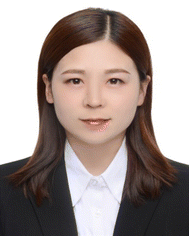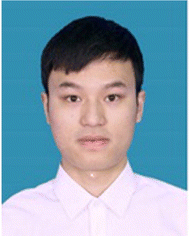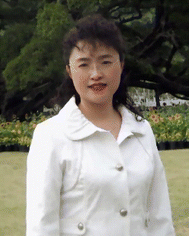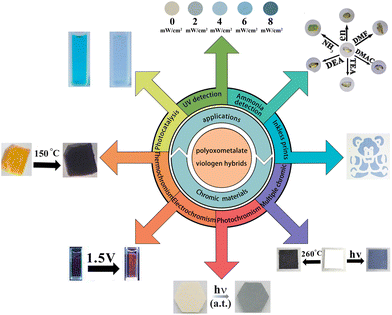Recent progress in polyoxometalate–viologen photochromic hybrids: structural design, photochromic mechanism, and applications
Li
Li
 *a,
Yang-Tao
Yu
a,
Yang
Hua
a,
Xiao-Nan
Li
b and
Hong
Zhang
*a,
Yang-Tao
Yu
a,
Yang
Hua
a,
Xiao-Nan
Li
b and
Hong
Zhang
 *b
*b
aSchool of Materials Science and Engineering, Henan Polytechnic University, Jiaozuo 454000, China. E-mail: lili@hpu.edu.cn
bInstitute of Polyoxometalate Chemistry, Department of Chemistry, Northeast Normal University, Changchun 130024, China. E-mail: zhangh@nenu.edu.cn
First published on 7th March 2023
Abstract
Polyoxometalate–viologen hybrids are a class of photochromic materials with variable structures and interesting application performance. In recent years, some progress has been made in polyoxometalate–viologen photochromic hybrids through rational structural design, realizing the development from thin film to crystalline state. In this review, we summarize recent progress on polyoxometalate–viologen hybrid photochromic materials, especially in structural design, photochromic mechanism, and applications such as photocatalysis, ultraviolet detection, detection of amines and inkless erasable printing.
1. Introduction
Photochromic materials with reversible color changes have received tremendous scientific attention for smart windows, molecular switching, data storage, anticounterfeiting and so on.1–15 Polyoxometalates (POMs) are a class of very important photochromic materials due to their good redox properties and photoactivity, and readily undergo photoinduced electron transfer to form Mo/W(V)-containing heteropolyblue.16–29 In general, purely inorganic POMs have poor photochromic behavior and are difficult to synthesize, while purely organic photochromic materials have poor fatigue resistance and high temperature resistance despite their fast response and rich color,30,31 so it has been difficult to find new photochromic materials in pure organic or inorganic systems. By contrast, organic–inorganic hybrid photochromic materials can not only maintain or even enhance the properties of the respective components, but also generate new properties based on the synergistic effect between the components, which is more attractive to researchers.32–36 In 2010, Dolbecq et al. published an interesting comprehensive review emphasizing the importance of organic–inorganic hybrids and proposing the potential applications of POMs as photochromic materials.37Among the known POM-based photochromic hybrids, the common organic ligands such as alkylammonium, multicarboxylic acid and sulfonium cations have been widely studied, and exhibit highly tunable photochromic properties with strong color changes.38–58 However, the color change in these systems is due to photoreduction of Mo/W6+ ions through electron transfer inside the POM moiety under UV light, and the organic counter ion only acts as a stabilizer of the reduced POM.59–62 In recent years, with the in-depth study of viologen-based photochromic compounds,63–77 researchers have found that electron-deficient viologen ligands are capable of hybridizing with electron-rich POMs; this can not only form hybrid materials with diverse structures, but also bring more outstanding redox properties, photoactivity and thermal stability.64,78–80 Currently, the viologen ligands used to construct POM-based photochromic hybrids have the following advantages: (1) viologen ligands, whose coordination sites are varied, can be easily modified, they can directly coordinate with the POMs or coordinate with transition metal ions first and then combine with POMs; (2) viologens not only act as counter ion but also take part in the coloration process, and can tune and optimize the photochromic property of POMs; (3) the combination of POMs with viologens can generate new properties in different fields such as photocatalysis, ultraviolet detection and so on.
POM–viologen hybrids as an important class of photochromic materials have been of wide interest for their excellent properties and application potential. Most early research on POM–viologen hybrid chromic materials focused on photo/electro chromic films.81–89 For example, in 2009, Xu's research group prepared a color-changing composite film containing POMs and viologen by using a layer-by-layer self-assembly method.88 It was not until 2010 that Sun et al. synthesized and reported the first case of POM–viologen photochromic crystalline material, namely 4,4′-bipyridine polymolybdate single crystal supramolecular compound,90 and POM–viologen photochromic crystalline materials are gradually becoming more attractive, not only because they facilitate in-depth exploration of structure–property relationships, but also because the synergy and complementarity between components can generate new properties for applications such as amine detection and ink-free printing.78,91–94 Subsequently, multi-stimuli-responsive materials have also been explored, which greatly promoted the ongoing development of POM–viologen hybrid photochromic materials.94–96
In the last few years, a series of research works on POM–viologen hybrids has been done by our group. The main purpose of this review is to combine these works with other research in the field to summarize the rules for the structure design, photochromic mechanism and properties (Fig. 1), which can serve as a guide for the synthesis of new materials in the future.
2. Structural design
As is well known, the structural design and synthesis of new POM–viologen photochromic materials has always been a challenge because of many factors including pH, the selection of solvent, the metal salt, reaction time, and most importantly, anionic structures and organic ligands determining the structure and property of the compound. In POM–viologen hybrid materials, the self-assembly form mainly includes the following three types: (1) viologen exists as counter cation; (2) viologen first coordinates with transition metal ions, and then introduces POMs; (3) viologen directly coordinates with the POM metal center. In this section, the three existing modes of viologen in POM-based hybrid photochromic materials will be introduced one by one.2.1. Viologen exists as counter cation
As anionic metal–oxygen clusters, POMs are good inorganic photochromic materials, while viologen and its derivatives are often positively charged electron-deficient compounds, so the unique positive charge characteristic of viologen can be used as a counter cation combining with electron-rich POMs.96,97 This kind of viologen is mostly in the form of double protonation, single protonation and alkyl substitution. At the same time, because viologen and POMs interact through electrostatic attraction, the distance between the two is relatively close. It is easier to generate C–H⋯O and N–H⋯O bonds building two-dimensional or three-dimensional topological structures by self-assembly, and also provide a way of electron transfer when stabilizing compounds.In 2010, the first case of POM–viologen crystalline photochromic hybrids (4,4′-bipyridine)Mo7O22·H2O was reported by Sun et al.90 The compound was obtained by hydrothermal synthesis comprising protonated 4,4′-bipyridine cations and polyoxomolybdate anions [Mo7O22]2− and crystal water, which are bound to each other by hydrogen bonding, electrostatic attraction and intermolecular forces, forming a two-dimensional network (Fig. 2a). The synthesis of this compound also opened the curtain of POM–viologen photochromic crystalline hybrid materials and began to attract more and more attention. For example, using C14H11N4O viologen cations and ammonium molybdate, we synthesized a novel neutral coordination compound (C14H11N4O)2[Mo8O26].79 The compound is composed of two isolated C14H11N4O cations and a [Mo8O26]4− anion (Fig. 2b), while the C14H11N4O monomer is hydrogen-bonded to the polyoxomolybdate by C–H⋯O and N–H⋯O. At the same time, to verify the difference between viologen and alkylammonium in the POM-based photochromic materials, taking the reported (H2pipz)3[Mo8O27] (containing no viologen) and (C14H11N4O)2[Mo8O26] as important examples, the photochromic mechanism of the compounds was studied in detail by using X-ray photoelectron spectroscopy (XPS), electron spin resonance (ESR), UV/Vis diffuse reflectance spectrum, IR, PXRD etc. The results reveal that the viologen ligand can not only stabilize POMs, but also participates in the photochromic process, while the organic counterion H2pipz only acts as a stabilizer to reduce POM. In addition, viologen can modulate the photochromic properties of polyoxomolybdate, showing a color modulation effect (Fig. 3b). There is a significant difference in the color change of the compound before and after photoirradiation, compared with the traditional monochromatic change. Such a new toning method may be helpful to improve the properties of the photochromic polyoxomolybdate family.
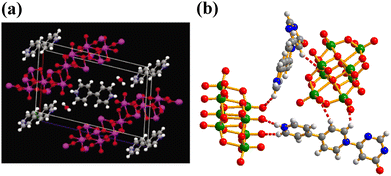 | ||
| Fig. 2 Molecular structure: (a) (4,4′-bipyridine)Mo7O22 (cited from ref. 90). (b) (C14H11N4O)2[Mo8O26] (cited from ref. 79). | ||
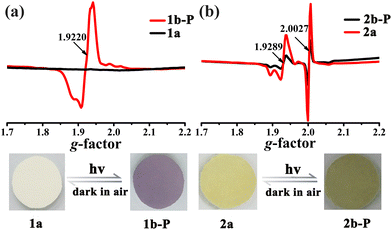 | ||
| Fig. 3 ESR spectra of (H2pipz)3[Mo8O27] (a) and (C14H11N4O)2[Mo8O26] (b) (cited from ref. 79). | ||
Nowadays POM–viologen hybrid crystalline photochromic materials combining multiple color-changing capabilities and exploring multifunction applications have become a research hotspot.98–103 For example, Guo et al. successfully prepared a new two-dimensional hybrid material EV[Mo9O28] (EV2+ = ethyl viologen cation) by introducing the ethyl viologen, a well-known electron acceptor, into the polyoxomolybdate layered structure.98 As shown in Fig. 4a, the polyoxomolybdate layer is isolated by EV2+, and the inorganic and organic components are linked by hydrogen bonds and CH⋯π interactions. The compound has dual color-changing properties: photochromic and thermochromic (Fig. 4b) with an ultralong-lived charge separation under illumination and heating, possibly due to the dense crystal packing mode that prevents contact with oxygen molecules. In the process of light/heat-induced discoloration, the generated Mo5+ and EV˙+ radical promote the electron transfer in the inorganic and organic components, respectively, resulting in a significant increase in the electrical conductivity of the compound.104,105 This work provides an alternative way to manipulate the electronic properties of 2D semiconductors via external stimuli rather than changing chemical composition, and has reference significance for the later research.106–113
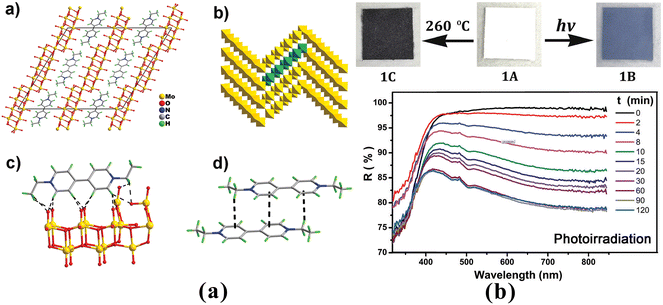 | ||
| Fig. 4 (a) Supramolecular structure and interaction force of EV[Mo9O28]. (b) Photochromic and thermochromic phenomenon (top) and I–V plots at 298 K (bottom, 300 W, ca. 110 mW cm−2) (cited from ref. 98). | ||
2.2. Viologen first coordinates with transition metal ions, and then introduces POMs
In this section, the existence form of viologen in POM–viologen hybrid photochromic materials is to coordinate with transition metal ions first and then combine with POMs. That is, transition metal ions with special electronic structure need to first coordinate with viologen and then use the unsaturated coordination sites to coordinate with the oxygen at the end of the POMs.114,115 The construction of such POM–viologen hybrid materials requires 4.4′-bipyridine to modify the coordination site, and viologen ligands containing carboxylic acid and pyridine groups are currently widely used. This type of structure helps to extend the wavelength response range, and may enable good photocatalytic activity in the visible and NIR light.In 2019, the Fu research group used a self-assembly and bottom-up design strategy to introduce phosphotungstate clusters into the main chain of the electron-deficient copper–viologen framework by copper substitution and ligand linkage.93 The compound is [Cu2(H2O)3(CPBPY)2(CuHPW11O39)]·7H2O and the [HPW11O39]6− anion is connected to the copper center by a covalent bond, forming a double chain connected by copper–viologen (Fig. 5). Supported by the design of the copper–viologen complex network structure, the compound exhibits an absorption range from UV to NIR with excellent photocatalytic activity. Because of the introduction of transition metal ions, a strong absorption band at 500–1500 nm can be clearly found by UV-Vis-NIR diffuse reflectance spectroscopy, which is due to the charge transfer between metal and organic ligands and the d–d leap of copper ions.116–119 Therefore, the introduction of transition metals into the POM anion cluster is beneficial for achieving the expansion of the light absorption range of POMs.
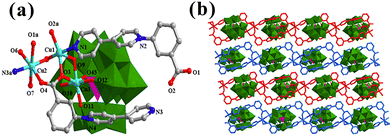 | ||
| Fig. 5 Structure of polyoxometalate–viologen hybrid photochromic materials with the introduction of transition metals (the compound is [Cu2(H2O)3(CPBPY)2(CuHPW11O39)]·7H2O). (a) The structural unit. (b) The spatial packing arrangement with CuHPW11O394− anions (cited from ref. 93). | ||
2.3. Viologen coordinates directly with the POM metal center
According to the conclusion proposed by Marcus,120 we can know that the closer the distance between the electron donor and the electron acceptor, the faster the electron transfer rate between them. But the dispersion of the salts in a solution will not favor the electron transfer. In order to obtain ultra-sensitive photochromic materials, we found that the assembly of viologen ligand and POMs in the coordination mode is an applicable method.In 2019,80 we synthesized two new covalently bonded POM–viologen crystalline photochromic hybrid materials [(Bpyen)2(Mo8O26)]·2H2O (Bpyen = 1,2-bis(4,4′-bipyridinium)ethane) and [(Pbpy)2(Mo8O26)]·4H2O (Pbpy = 1,1′-[1,4-phenylenebis-(methylene)]bis(4,4′-bipyridinium)) (Fig. 6). Covalently bonded hybrid materials are very rare in the system of POM-based photochromic materials.121–125 We think that the successful synthesis of these two compounds was related to the correct choice of POMs, viologen and pH adjustment of solution. Firstly, (NH4)6Mo7O24·4H2O readily transformed into γ-[Mo8O26]4− with the open Mo sites under hydrothermal conditions. Secondly, the ligands of the above two viologens contain two terminal pyridyl N atoms, which can coordinate with the open Mo sites. Finally, the 1 mol L−1 hydrochloric acid was used to adjust the mixed solution so that its pH was in the acidic range. Compared with other photochromic compounds that have been reported, the photoreaction rates of 1 and 2, respectively, are 5 s and 1 s (Fig. 7). These phenomena indicate that the covalent bond between viologen and POM components does benefit the electron transfer.
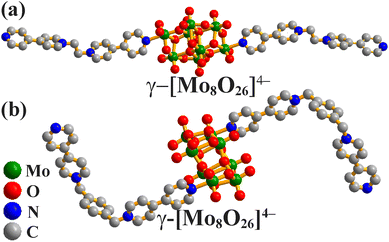 | ||
| Fig. 6 Molecular structures of [(Bpyen)2(Mo8O26)]·2H2O (a) and [(Pbpy)2(Mo8O26)]·4H2O (b) (cited from ref. 80). | ||
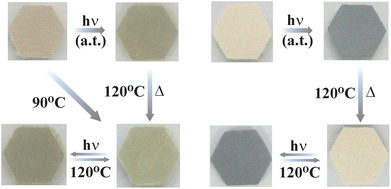 | ||
| Fig. 7 Photochromic phenomenon of [(Bpyen)2(Mo8O26)]·2H2O (left) and [(Pbpy)2(Mo8O26)]·4H2O (right) (cited from ref. 80). | ||
In short, the different self-assembly forms between POMs and viologen ligands will have different effects on the hybrid materials including photoresponse rate, reversibility and fatigue resistance. In addition, it can produce different properties; for example, viologen first coordinates with transition metal ions, and then introduces POMs, which has potential photocatalytic properties. Viologen coordinating directly with the POM's metal center can as well ink-free printing medium due to fast photoresponse rate. Therefore, we summarized the above three assembly forms of POMs and viologen in the hope of providing some help for the synthesis of POMs–viologen hybrid photochromic materials in the future.
3. Photochromic mechanism
As promising candidates for photoresponsive materials, study of the inherent photochromic mechanism is very important. In POM–viologen hybrid photochromic materials, the electron transfer (ET) mechanism is widely utilized, which includes two basic objects: electron donor and electron acceptor, and the electron-deficient viologen ligand usually plays the role of electron acceptor. For example, in 2017, Gao and co-workers prepared a novel solar UV-sensitive photochromic film (denoted as PVP/PEI/EuW10/AV2+) composed of POMs and viologen on quartz substrate by the drop-casting method.126 Under the irradiation of solar ultraviolet light, the photochromic film was transformed to the blue state, visualized by the naked eye, with good fatigue resistance (Fig. 8), and it showed no changes under solar visible light, giving it considerable potential for novel portable durable solar UV detection devices. In this paper, the inferred photochromic mechanism was that it is due to the electron transfer from PVP carbonyl group to viologen ligands.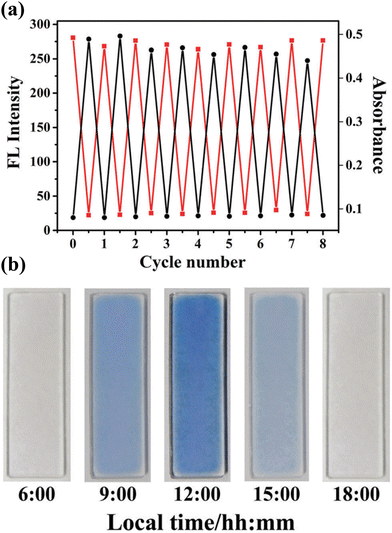 | ||
| Fig. 8 (a) Changes in the emission intensity at 600 nm (red line, irradiation intensity at 254 nm) and absorption intensity at 610 nm (black line) of the photochromic hybridized film over 8 cycles. (b) Photographs of the hybridized film in sunlight at different times of the day in the local area (Jiamusi). The exposure time was 10 min (cited from ref. 126). | ||
Compared with film materials, crystalline materials are more helpful for studying the mechanism of photochromism. In 2015, Gao's group developed a novel crystalline photochromic and luminescent switchable material, [(AV2+)(p-AV)(EuW10O36)]n·2nH2O (p-AV = poly(1-ethyl-1′-butyl-4,4′-bipyridinium), that can respond quickly after UV irradiation (Fig. 9). They think the coloration mechanism originates from an electron-transfer process and viologen ligands as electron acceptor. In the process of photochromism, POMs just act as photosensitizers.96
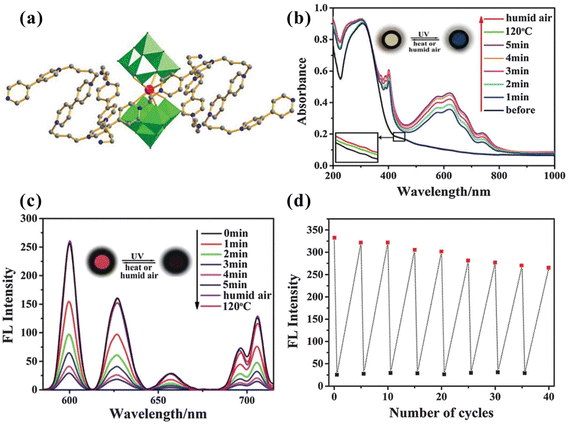 | ||
| Fig. 9 (a) Molecular structure of [(AV2+)(p-AV)(EuW10O36)]n·2nH2O; (b) UV-Vis absorption spectra of compound. (c) Time-dependent photoluminescence spectra (emission: 254 nm), its recovery spectra on exposure to humid air (95%, 5 min) or on heating at120 °C for 10 min. (d) The different cycles (emission intensity: 601 nm, emission: 254 nm) (cited from ref. 96). | ||
However, the interaction between viologen ligands and POMs and the effects of different viologen ligands on POMs have not been well understood. So, the photochromic mechanism based on POM–viologen hybrids requires further in-depth study. To realize this aim, we chose two viologen ligands with different electron-withdrawing ability and synthesized two crystalline compounds [(Bpyen)2(Mo8O26)]·2H2O (1) and [(Pbpy)2(Mo8O26)]·4H2O (2).80 In this work, we explored the photochromic mechanism and structure–property relationship, and drew the following two conclusions: (1) the photochromic mechanism is electron-transfer from OMo–O atoms to viologen and Mo(VI); (2) the viologen ligands with weak electron-withdrawing ability favor electron-transfer to Mo(VI).
We take compound [(Bpyen)2(Mo8O26)]·2H2O as an important example to analyze conclusion 1. The in situ electron spin resonance (ESR) experiments showed two distinct signals at g values of 2.0039 and 1.9514 (Fig. 10a), which, respectively, corresponded to the viologen free radicals and Mo(V). From the above conclusion, we can infer that viologen and POMs act as electron acceptors. However, there are two types of oxygen atom from H2O and γ-[Mo8O26]4−, and both are potential electron donors. Combining the facts that the decolored sample after losing water still changes color and the shortest OMo–O⋯N+ distance is 2.6453(4) Å, we think that OMo–O from γ-[Mo8O26]4− should be the electron donor. Electrostatic potential (ESP) surfaces further prove the above conclusion (Fig. 11a). By comparing the ESR spectra of the identical mole quantities, we found that the signal peak of Mo(V) is obviously stronger than [Pbpy]˙+ radicals in [(Pbpy)2(Mo8O26)]·4H2O. Moreover, the absorption band around 598.8 nm of Mo(V) is also clearly stronger than [Pbpy]˙+ radicals at 470.5 nm and above 800 nm in the UV-vis spectra (Fig. 12b). These data showed that electrons of the OMo–O atoms in [(Pbpy)2(Mo8O26)]·4H2O are mainly transferred to the Mo(VI) upon irradiation. The LUMO level of (Pbpy) is higher than that of (Bpyen) (Table 1), which implies that the electron-withdrawing ability of Pbpy is weaker than that of Bpyen and explains the reason why electrons tend to transfer to Mo(VI) in [(Pbpy)2(Mo8O26)]·4H2O. That is to say, the weak electron-withdrawing ability of the coordinated ligand favors photoreduction of Mo(VI) to Mo(V). These discoveries will help in improving performance for the well-known photochromic polyoxomolybdate family.
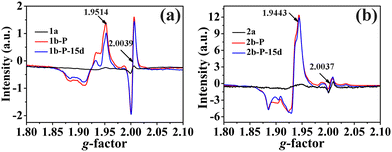 | ||
| Fig. 10 (a) The in situ electron spins resonance (ESR) spectra with equal molar quantity of [(Bpyen)2(Mo8O26)]·2H2O. (b) The in situ electron spins resonance (ESR) spectra with equal molar quantity of [(Pbpy)2(Mo8O26)]·4H2O (cited from ref. 80). | ||
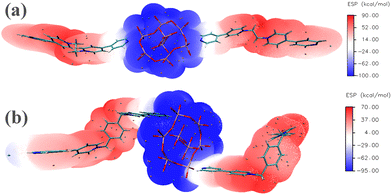 | ||
| Fig. 11 Electrostatic potential (ESP) surfaces of compounds [(Bpyen)2(Mo8O26)]·2H2O (a) and [(Pbpy)2(Mo8O26)]·4H2O (b) (cited from ref. 80). | ||
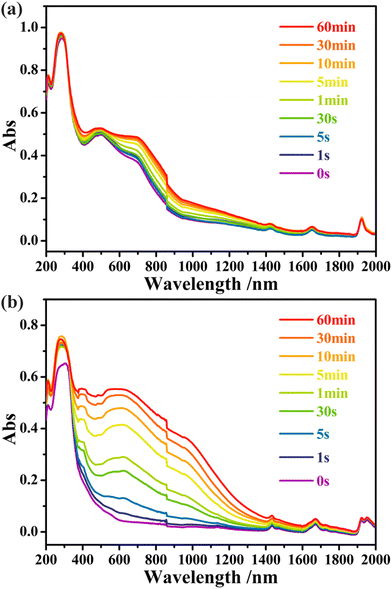 | ||
| Fig. 12 UV-Vis absorption spectra of compounds [(Bpyen)2(Mo8O26)]·2H2O (a) and [(Pbpy)2(Mo8O26)]·4H2O (b) (cited from ref. 80). | ||
| 1 | 2 | |
|---|---|---|
| a TD-DFT (B3LYP/6-31G+g(d,p)). | ||
| The shortest OMo–O⋯N+ distance (Å) | 2.6453(4) | 2.6540(5) |
| Dihedral angle (Å) between two pyridyl groups of the coordinated 4,4′-bipyridinium | 50.1(1) | 0.9(2) |
| Face-to-face π⋯π distance (Å) between pyridine rings | No | 3.8378(3) |
| Ligand, LUMO energy (eV) | Bpyen, −9.02 | Pbpy, −8.19 |
| Oscillator strength f (radical)a | 0.003 ([Bpyen]˙+) | 0.006 ([Pbpy]˙+) |
4. Applications
As a new type of intelligent material, photochromic materials have been widely used in dyes, glasses, inks etc.127–141 However, the exploration of photochromic materials should not be confined only to their color-changing properties, so in recent years, combining the photochromic phenomenon with other properties to explore new multifunctional materials has attracted a lot of attention.POM–viologen hybrids as an important class of photochromic materials not only retain the advantages of POMs and viologen, but also produce new properties through the rational design of POMs and viologen ligands. The reasons are as follows: (1) viologen compounds have a fast photoresponse ability, visible color change and good reversibility, while POMs as inorganic semiconductor materials have a large gap between their well-defined HOMO and LUMO.142 Therefore, the possibility arose for the preparation of photochromic hybrid materials with a large energy gap preventing absorption in the visible and infrared regions, which can be used for UV detection; (2) the POM–viologen hybrid materials have an excellent reversibility and fast response ability under external stimuli such as light, solvents and organic amines, which brings some new opportunities for application and development in inkless erasable printing, detection of amine toxic substances, anion/cation detection and so on. The following is an introduction to the research progress on the application of POM–viologen hybrid photochromic materials. We hope our work can provide some help for the design of multifunctional POM–viologen hybrid photochromic materials.
4.1 Photocatalytic degradation
Photocatalytic technology is a simple, efficient and energy-saving green environmental protection technology, which plays an important role in the remediation of water pollution and the control of organic pollutants.143–146 POMs can form peroxy complexes or catalytically active metal ions in the highly oxidized state, and thus have been widely used as effective oxidants for the removal of organic pollutants. However, their high solubility in aqueous solution and low stability under catalytic conditions mean they have low recoverability and recovery rates in the practical application process.147–153 Although these problems have been solved by immobilizing POMs on solid carriers (such as TiO2, SiO2 and organic polymers), there are still some other problems such as leaching of POMs, narrow absorption bands, inhomogeneous sites and unclear structures.154 Therefore, the design and synthesis of efficient photocatalysts with clear structures and precise distribution of catalytic active sites remains a difficult research task.In recent years, the crystalline organic–inorganic composite hybrids have provided a new possibility for the combination of the redox properties of organic polyoxymethylene with metal–organic frameworks. This is an effective way to stabilize and improve traditional POM fragments.155–162 In 2018, Fu and co-workers designed and constructed a highly efficient photocatalyst based on the broadband solar response molecular system [Cu2(CPBPY)4(H2O)2][PW12O40][OH]·6H2O (CPBPY![[double bond, length as m-dash]](https://www.rsc.org/images/entities/char_e001.gif) N-(3-carboxyphenyl)-4,4′-bipyridinium) (Fig. 13).92 With the metal–viologen framework as media, the complex can lengthen the absorption spectrum from UV to the NIR region, especially in the NIR region, which enables the photocatalyst to degrade wastewater effectively. As shown in Fig. 13c, the photodegradation of methylene blue (MB) solution under different light irradiation conditions was investigated. The MB solution was observed to be completely degraded in 30 min under full spectrum light irradiation. Under visible and NIR light irradiation, around 98.2% of MB was degraded within 60 min. But for the contrast reaction without catalyst, the degradation rate of MB solution as shown in Fig. 13d is obviously lower. The above results indicate that the addition of electron-rich POM to metal–viologen frameworks is a promising strategy to explore more full-spectrum POM catalysts.
N-(3-carboxyphenyl)-4,4′-bipyridinium) (Fig. 13).92 With the metal–viologen framework as media, the complex can lengthen the absorption spectrum from UV to the NIR region, especially in the NIR region, which enables the photocatalyst to degrade wastewater effectively. As shown in Fig. 13c, the photodegradation of methylene blue (MB) solution under different light irradiation conditions was investigated. The MB solution was observed to be completely degraded in 30 min under full spectrum light irradiation. Under visible and NIR light irradiation, around 98.2% of MB was degraded within 60 min. But for the contrast reaction without catalyst, the degradation rate of MB solution as shown in Fig. 13d is obviously lower. The above results indicate that the addition of electron-rich POM to metal–viologen frameworks is a promising strategy to explore more full-spectrum POM catalysts.
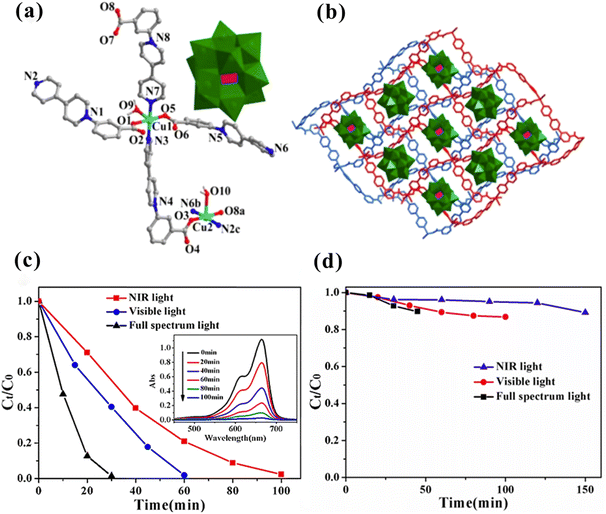 | ||
| Fig. 13 (a) Coordination modes of the Cu ion in [Cu2(CPBPY)4(H2O)2][PW12O40][OH]·6H2O. (b) The packing arrangement with encapsulated PW12O403− anions. (c) Photocatalytic degradation of MB. Inset: UV-Vis absorption spectrum of MB solution during NIR light photodegradation. (d) Degradation rates of MB (the contrast reaction without catalyst) (cited from ref. 92). | ||
Based on the above research results, in 2019, using self-assembly and bottom-up design strategies, the same research group introduced the electron-rich phosphotungstate clusters with photocatalytic activity into the backbone of an electron-deficient copper–viologen framework; the compound is [Cu2(H2O)3(CPBPY)2(CuHPW11O39)]·7H2O.93 This designed catalytic molecular system has a high photooxidative ability for the degradation of dye pollutants, and has a photostimulated response effect in ultraviolet, visible light, and even near-infrared light. As shown in Fig. 14a, the MB solution can be completely degraded within 20 min under full-spectrum light irradiation. Within 40 min of visible light irradiation, its degradation rate is about 99.3%. Incredibly, the degradation rate is close to 100% after 80 min of NIR light irradiation. In contrast, photodegradation rates are almost negligible in the absence of catalysts (Fig. 14b). At the same time, the stability of the compound is quite good, and its photocatalytic activity does not decrease significantly after 5 rounds of degradation of MB by irradiation with various light sources. In addition, it also exhibited highly efficient photodegradation activity towards the organic dyes rhodamine B and methyl orange (Fig. 14c and d). In this study, the POMs/CP linkage framework with broad-spectrum photocatalytic activity is reported for the first time, which opens up a promising way for future research on efficient full-spectrum activated POM catalysts.
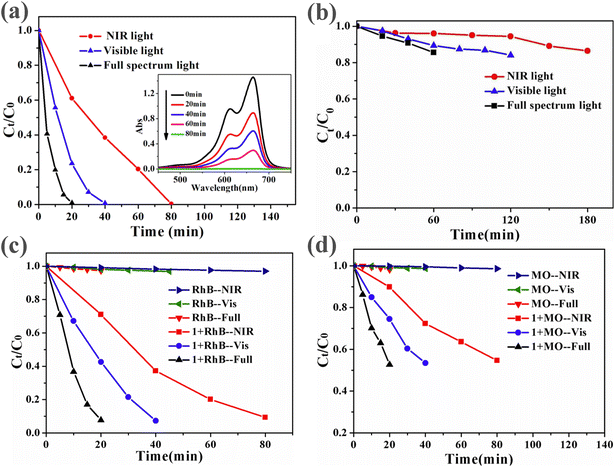 | ||
| Fig. 14 Demonstration of the comparative effect of catalytic degradation with or without catalyst: (a) Degeneration rates of MB. (b) Degeneration rates of MB without catalyst. (c) Degeneration rates of RhB with catalyst and the blank reaction without catalyst. (d) Degeneration rates of MO with catalyst and the blank reaction without catalyst (cited from ref. 93). | ||
4.2 Ultraviolet detection
The ultraviolet radiation brought by sunlight is a kind of natural stimulation radiation that human beings cannot avoid. Objectively speaking, moderate solar ultraviolet rays have certain benefits, such as promoting the body's calcium absorption, effectively killing of the body's surface bacteria to strengthen skin resistance and prevent anemia, etc. But transitional solar ultraviolet radiation can cause considerable harm to the human body, such as accelerating skin aging and skin inflammation, even leading to skin cancer, and it also causes eye discomfort and other adverse problems.163–167 So especially in hot summer and in certain environments, it is important to determine the UV intensity quickly and easily.168 Therefore, it is attractive and challenging to develop a simple, portable and efficient UV sensor for daily life.In recent years, we have found that viologen-based photochromic materials have good reversibility, fast optical response rate and visible color change, and have potential as novel ultraviolet light detectors. However, to develop an efficient UV light detector, the color or spectrum of the visible light region needs to be unchanged to ensure good detection capability in the UV light region.126,167 Therefore, to solve this problem, the materials designed for synthesis should be considered as having a large energy gap, thus preventing them from absorption response phenomena in the visible and infrared regions. As we know, POMs have a large energy difference between their well-defined highest occupied molecular orbital energy level (HOMO) and lowest unoccupied molecular orbital energy level (LUMO).142 So, by introducing POMs, the energy level of viologen compounds can be changed. The HOMO and LUMO of the synthesized POM–viologen hybrid material produce a large energy difference, so that the compound with a larger energy gap can realize the possibility of reducing the visible light response to stimuli.
In 2019, our group reported a new type of polyoxometalate–viologen hybrid crystalline photochromic material (Pbpy)(Me2NH2)3[PW11ZnO40] (Pbpy = 1,1′-[1,4-phenylenebis-(methylene)] bis(4,4′-bipyridinium)).91 As shown in Fig. 15a, the asymmetric unit consists of one polyoxoanion, one viologen cation and three Me2NH2+ ions to achieve the purpose of charge balance. In this compound, the three-dimensional structures have been also constructed through electrostatic interactions and strong intermolecular hydrogen bonds due to viologen cations, Me2NH2+ ions and polyoxoanions coming into contact with each other (Fig. 15b). Meanwhile, the π⋯π interactions between the viologen cations in the compound may be useful for the improvement of the stability of the photoinduced generated viologen radicals,169–175 thus improving the light response speed of the material. When irradiated with ultraviolet rays in the atmospheric environment, we can observe with the naked eye that the color of the compound quickly changes from yellow to blue, but the irradiated samples can be completely decolorized after heat treatment at 130 °C for 2 h in air, which indicates that the discoloration and fading process of the material is reversible (Fig. 15d). In addition, the compound does not change color under visible light, but can show significantly different color changes under different intensities of ultraviolet light (Fig. 15c). This characteristic can be useful for UV detection. Moreover, a thin film was prepared based on the material by the drop casting method on a quartz substrate and, as shown in Fig. 15f, the film showed a considerable difference in color change within 2 minutes when it was exposed to sunlight for different times on a sunny day. Therefore, the POM–viologen hybrid photochromic material has great application potential as a portable solar ultraviolet detection device that can be observed and recognized by the naked eye and used for daily protection in practical life.
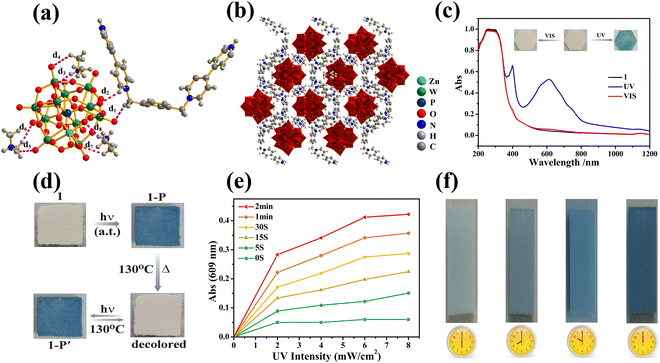 | ||
| Fig. 15 (a) The asymmetric unit of (Pbpy)(Me2NH2)3[PW11ZnO40]. (b) Polyhedral representation of the three-dimensional structure by hydrogen bonds connecting in compound. (c) UV-Vis absorption spectra. (d) Photochromic phenomenon. (e) A plot of absorption changes at 609 nm as a function of irradiation time at different UV intensities (mW cm−2). (f) The portable compound film is used to detect the solar UV intensity at different time periods (Changchun) (cited from ref. 91). | ||
4.3 Amines detection
Amines are known to be toxic and can be easily inhaled or ingested, causing great harm to the human body, such as inhibiting the nervous system and cardiovascular system, causing damage to the skin or causing cancer.176–178 Therefore, it is necessary to develop effective means to detect toxic amines.Viologen compounds as photochromic materials have attracted more and more attention. The electron-deficient viologen cation (V2+) has the ability to form single-electron radicals through electron transfer from suitable electron donors, and amines happen to be good electron donors, so introducing viologens into a metal organic framework (MOF) can make it possible to visualize the detection of amines.7,179 In recent years, there have been some examples of using MOF materials to detect amines, but most of the reports are based on the enhancement of lanthanide ions, fluorescence quenching and aromatic fluorophores, and there are few gas-chromic MOF materials or multifunctional materials.180–187
In 2021, Wang et al. synthesized three POMs–viologen hybrid compounds by introducing viologen ligands into the POMs system,78 namely [Ag′(bmypd)0.5(β-Mo8O26)0.5], [Ag′2(bypy)4(HSiW12O40)2]·14H2O, and [Ag′(bypy)(γ-Mo8O26)0.5] (Fig. 16). These three synthetic photochromic compounds have outstanding photoresponse properties and all exhibit amine vapour color reactions. When exposing the compound to saturated amine vapour, the crystals undergo different color changes. For example, when the compound [Ag′(bmypd)0.5(β-Mo8O26)0.5] was exposed to NH3 for 3 minutes, the color of the compound changed from light yellow to green. After it was placed in ethylenediamine (en), DMF and diethanolamine (DEA) steam atmosphere for 10 min, the color of the compound underwent a noticeable change that was visible to the naked eye. However, the color change of the compound was not obvious after it was placed in a dimethylacetamide (DMAC) or DEA environment for 1 h (Fig. 17). Therefore, these compounds can be applied to the detection of toxic organic amine substances, especially for the detection of NH3 in a standard environment. So far, there have been few studies on the combination of viologen and POMs to construct new photochromic materials and amine detection materials, most of which are some viologen-based metal–organic complexes with good photochromic properties and amine detection properties. The above research group showed the great potential of POM–viologen hybrid photochromic materials for the rapid and effective detection of amine toxic gases.
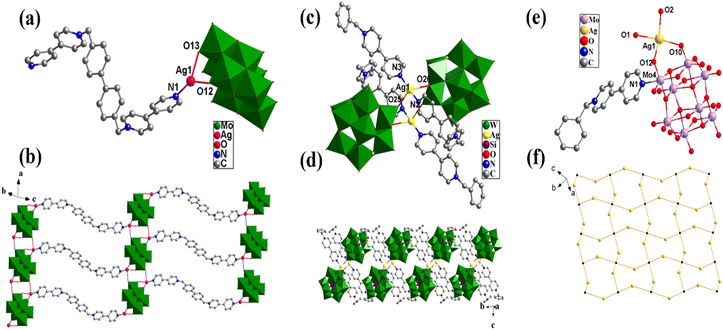 | ||
| Fig. 16 (a) The unit cell diagram of [Ag′(bmypd)0.5(β-Mo8O26)0.5]. (b) The 2D layer of [Ag′(bmypd)0.5(β-Mo8O26)0.5]. (c) The unit cell diagram of compound [Ag′2(bypy)4(HSiW12O40)2]·14H2O. (d) The 1D supramolecular chain of compound [Ag′2(bypy)4(HSiW12O40)2]·14H2O. (e) The unit cell diagram of compound [Ag′ (bypy)(γ-Mo8O26)0.5]. (f) The 2D topological mesh of compound [Ag′(bypy)(γ-Mo8O26)0.5] (cited from ref. 78). | ||
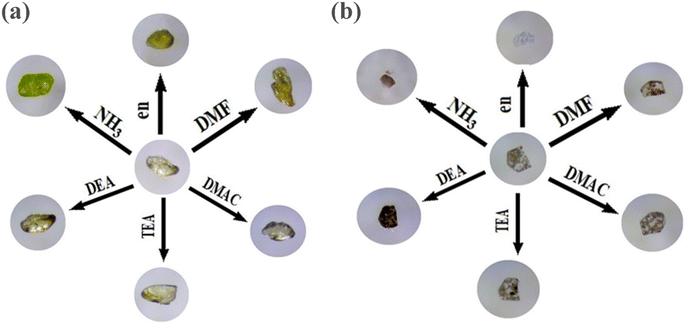 | ||
| Fig. 17 Amine detection effect picture of [Ag′(bmypd)0.5(β-Mo8O26)0.5] (a) and [Ag′(bypy)(γ-Mo8O26)0.5] (b) (cited from ref. 78). | ||
However, in the detection of toxic amines, how to quickly and conveniently analyze and determine the category and concentration of toxic amines is still a huge challenge, and it is of great significance to human life and health and rapid treatment. In 2022,188 Gao and co-workers synthesized and reported a class of highly sensitive POM–viologen crystalline photochromic hybrid materials with selective detection for ethylenediamine (H2AV)[H2(P2W18O62)]·9.5H2O (AV = N,N′-bis(δ-aminopropyl)-4,4′-bipyridinium)(Fig. 18). The complex has a special selective response to EDA gas, from white to dark blue (Fig. 19a). Regarding other amines, they may not react with the complex or the reaction is not obvious due to electron push effect or size effect. In order to directly reflect its sensitivity in detecting concentration changes, the complex was placed in EDA gas of different concentrations. It was found that the color of the complex changed from blue to dark blue with the increase of concentration (Fig. 19b and c). It is worth noting that detection by visual resolution and UV-vis spectroscopy can only deliver visual and rapid response to EDA gases at concentrations above 30 ppb. Therefore, Gao et al. adopted the Raman spectrum detection method, effectively solving the above problems, and through photochromism and the Raman signal to EDA gas achieved a super sensitive response, improving the detection limit of EDA, up to 0.1 ppb. This is of great significance for the accurate detection and identification of toxic amines, and also broadens the application and development of POMs–viologen hybrid materials.
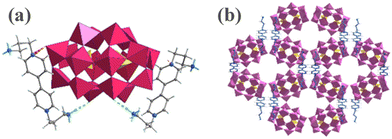 | ||
| Fig. 18 (a) The combined ball–stick and weak interactions between the AV2+ monomer and [P2W18O62]6− (a) and 2D framework of (H2AV)[H2-(P2W18O62)]·9.5H2O (b) (cited from ref. 188). | ||
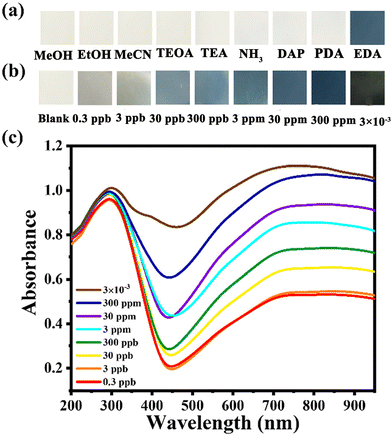 | ||
| Fig. 19 (a) Color changes of the complex after treatment with different solvents: methanol (MeOH), ethanol (EtOH), acetonitrile (MeCN), triethanolamine (TEOA), triethylamine (TEA), NH3, 1,3-diaminopropane (DAP), 1,5-pentane-diamine (PDA), and ethylenediamine (EDA). (b) Color changes under different concentrations of EDA gas. (c) Changes of UV-visible absorption spectra under different concentrations of EDA gas (cited from ref. 188). | ||
4.4 Inkless and erasable printing
Photochromic materials are able to change their original color on external stimulation and do not require dye for staining, so these materials have been used in the field of erasable and inkless printing.189–197 Compared with traditional printing technology,198–201 the development of ink-free erasable printing technology could reduce the excessive dependence of the printing industry on ink, and at the same time alleviate the environmental pollution and damage caused by excessive use of ink and excessive cutting down of trees. Therefore, the development of inkless erasable printing materials is of great help to improve the environmental pollution problem. However, not all photochromic materials can be used as inkless erasable printing materials, which not only need to have good color retention after photochromism for people to use for a period of time, but also require the printed content to erase itself without the influence of any external factors. This reversible self-erasing function enables the same sheet of paper to be used multiple times, thereby avoiding the one-time use of paper in printing, making printing not only cost-effective but also more environmentally friendly.In 2019, we reported a new type of POM–viologen hybrid crystalline photochromic material (Pbpy)(Me2NH2)3[PW11ZnO40].91 The compound has obvious color change from pale yellow to blue under ultraviolet light. The irradiated sample could be completely decoloured after annealing at 130 °C for 2 h in air or after storage in the dark in air for more than 2 d. Due to the sensitivity of the light response, good reversibility and fatigue resistance, the synthesized compounds can be used as ink-free erasable printing materials. As shown in Fig. 20, in order to study the effect of inkless printing, the crystalline compounds are ground into powders, immersed in ethanol, and then sonicated for 40 minutes to form suspensions.202,203 The resulting suspension is then evenly dripped onto a large piece of filter paper and air-dried at room temperature. The pattern template ready for printing is covered with the upper layer of the filter paper. After 30 seconds of UV light irradiation, the template is removed from the upper layer of filter paper, we can see that the pattern to be printed has been clearly printed on the paper, and the pattern is presented in blue. The printed content can be read and used for 11 days in a normal environment, and can be printed and used repeatedly, which can fully meet people's needs for daily short-term use (Fig. 21).
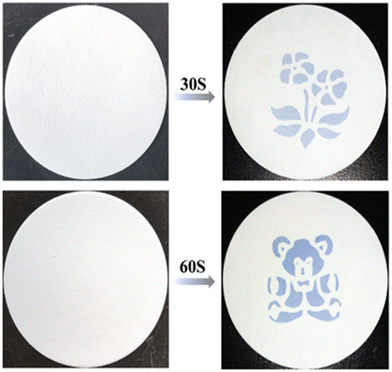 | ||
| Fig. 20 Photographs of a pattern printed without ink under light irradiation (cited from ref. 91). | ||
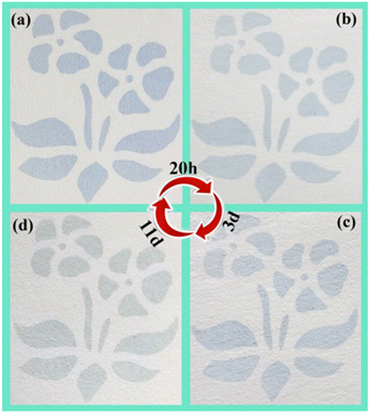 | ||
| Fig. 21 Photograph of a flower pattern printed inkless on paper and the effect of preserving the pattern at room temperature: (a) Photograph of content printed on one coated paper with a flower motif. (b) Printing of the content after 20 h. (c) Printing of the content after 3 days. (d) Photograph of the paper after printing for the 11 days (cited from ref. 91). | ||
5. Conclusions and outlook
In this review, we have summarized the research progress of POM–viologen hybrid photochromic materials with a focus on the structural design, photochromic mechanism, and applications.Due to the easy modification of viologen ligands, the self-assembly form mainly includes viologen as counter cation, viologen first coordinating with transition metal ions, and then introducing POMs, viologen directly coordinating with the POMs. In addition, the synergetic feature between viologen and POMs, for instance, competing electron transfer process, new knowledge on photochromic mechanism, and appealing applications have also been provided. This paper for the first time reviews POM–viologen hybrid photochromic compounds and systematically discloses their underlying structure–property relationships, which will shed useful insights into how to rationally design and synthesize new POMs–viologen hybrid photochromic compounds with improved performances. Below, we give a brief overview of future prospects in this area.
5.1 structural design and photochromism
As is well known, the structural design and performance modulation of novel POM–viologen hybrid photochromic materials have been a challenge because of many factors, including the concentration and molar ratio of the starting materials, reaction time, pH, nature of the solvent, and, most importantly, the anion structure and the organic components that determine the structure and properties of the compound. For example, the covalently bonded neutral coordination molecule is easily formed by combining polyoxomolybdate and viologen with terminal pyridyl N atoms. The POM–viologen MOF photochromic materials are easily constructed by keggin polyanions such as SiW12O404−, PW12O403−, PMo12O403−, bipyridinium derivatives with terminal carboxylate, and metal ions.The photochromic property of POMs can be tuned using the different electron-withdrawing abilities of viologen ligands. Therefore, the viologen ligands with strong electron-donating groups, such as –CH3, –C(CH3)3, etc., favor photoreduction of Mo(VI) to Mo(V). The viologen ligands with strong electron-withdrawing groups, such as –NO2, –CN, –F, etc., are conducive to the transfer of electrons to viologen.
5.2 Application prospects
As a new type of stimulation-responsive intelligent material, POM–viologen hybrid photochromic materials have some advantages, such as good stability, strong photosensitivity and outstanding reversibility, showing potential applications in photocatalysis, ultraviolet detection, detection of amines, inkless and erasable printing and so on. At present, the future application and development of POM–viologen hybrid photochromic materials will mainly focus on the following aspects: optimization of the performance of POM–viologen hybrid photochromic materials, including light response rate, fatigue resistance, and exploration of new application potential; for example, heterogeneous photocatalytic organic reactions limited by the low-efficiency carrier separation of the currently available photocatalytic materials. The addition of electron-deficient viologen helps the compound in the fast and continuous consumption of photogenerated electrons, which may be promising in facilitating the separation of electron–hole pairs to improve photocatalytic performance.In brief, POM–viologen hybrid photochromic materials have been developed in recent years. However, to date there are many application performances waiting to be explored; we hope that our work is helpful for researchers of photochromic materials in the future, and provides some ideas in the development of POMs–viologen photochromic hybrids.
Conflicts of interest
The authors declare that they have no known competing financial interests or personal relationships that could have appeared to influence the work reported in this paper.Acknowledgements
This work was supported by the Fundamental Research Funds for the Universities of Henan Province of China (NSFRF220404), Key Research Project of Higher Education Institutions of Henan Province of China (23A430025) and Science and technology project of Henan Province (NSFRF230617).References
- S.-D. Han, J.-X. Hu and G.-M. Wang, Recent advances in crystalline hybrid photochromic materials driven by electron transfer, Coord. Chem. Rev., 2022, 452, 214304 CrossRef CAS.
- T.-L. Yu, Y.-M. Guo, G.-X. Wu, X.-F. Yang, M. Xue, Y.-L. Fu and M.-S. Wang, Recent progress of d10 iodoargentate(I)/iodocuprate(I) hybrids: Structural diversity, directed synthesis, and photochromic/thermochromic properties, Coord. Chem. Rev., 2019, 397, 91–111 CrossRef CAS.
- L. Liu, Q. Liu, R. Li, M.-S. Wang and G.-C. Guo, Controlled Photoinduced Generation of “Visual” Partially and Fully Charge Separated States in Viologen Analogues, J. Am. Chem. Soc., 2021, 143, 2232–2238 CrossRef CAS PubMed.
- G.-E. Wang, G. Xu, N.-N. Zhang, M.-S. Yao, M.-S. Wang and G.-C. Guo, From Lead Iodide to a Radical Form Lead-Iodide Superlattice: High Conductance Gain and Broader Band for Photoconductive Response, Angew. Chem., Int. Ed., 2019, 58, 2692–2695 CrossRef CAS PubMed.
- C. Li, X.-Y. Li, S.-D. Han, J. Pan, J.-H. Li and G.-M. Wang, Luminescent Turn-On/Turn-Off Sensing Properties of a Water-Stable Cobalt-Based Coordination Polymer, Cryst. Growth Des., 2021, 21, 2332–2339 CrossRef CAS.
- T. Gong, Q. Sui, P. Li, X.-F. Meng, L.-J. Zhou, J. Chen, J. Xu, L. Wang and E.-Q. Gao, Versatile and Switchable Responsive Properties of a Lanthanide-Viologen Metal–Organic Framework, Small, 2019, 15, 1803468 CrossRef PubMed.
- Q. Sui, P. Li, N.-N. Yang, T. Gong, R. Bu and E.-Q. Gao, Differentiable Detection of Volatile Amines with a Viologen-Derived Metal–Organic Material, ACS Appl. Mater. Interfaces, 2018, 10, 11056–11062 CrossRef CAS PubMed.
- C. Zhang, L. Sun, Y. Yan, H. Shi, B. Wang, Z. Liang and J. Li, A novel photo- and hydrochromic europium metal–organic framework with good anion sensing properties, J. Mater. Chem. C, 2017, 5, 8999–9004 RSC.
- T. Yu, L. An, L. Zhang, J. Shen, Y. Fu and Y. Fu, Two Thermochromic Layered Iodoargentate Hybrids Directed by 4- and 3-Cyanopyridinium Cations, Cryst. Growth Des., 2014, 14, 3875–3879 CrossRef CAS.
- Y. Hua, N.-N. Zhang, M. K. Wang, S.-Q. Wang and L. Li, Cd-Viologen photochromic coordination compound for inkless and erasable printing and amine-selective sensing, Dyes Pigm., 2021, 194, 109595 CrossRef CAS.
- Q.-Y. Pan, M.-E. Sun, C. Zhang, L.-K. Li, H.-L. Liu, K.-J. Li, H.-Y. Li and S.-Q. Zang, A multi-responsive indium-viologen hybrid with ultrafast-response photochromism and electrochromism, Chem. Commun., 2021, 57, 11394–11397 RSC.
- J.-K. Sun, L.-X. Cai, Y.-J. Chen, Z.-H. Li and J. Zhang, Reversible luminescence switch in a photochromic metal–organic framework, Chem. Commun., 2011, 47, 6870–6872 RSC.
- X. Zhang, Z. Ma, X. Li, C. Qian, Y. Liu, S. Wang, X. Jia and Z. Ma, Multiresponsive Tetra-Arylethene-Based Fluorescent Switch with Multicolored Changes: Single-Crystal Photochromism, Mechanochromism, and Acidichromism, ACS Appl. Mater. Interfaces, 2021, 13, 40986–40994 CrossRef CAS PubMed.
- S.-L. Li, M. Han, Y. Zhang, G. P. Li, M. Li, G. He and X. M. Zhang, X-ray and UV Dual Photochromism, Thermochromism, Electrochromism, and Amine-Selective Chemochromism in an Anderson-like Zn7 Cluster-Based 7-Fold Interpenetrated Framework, J. Am. Chem. Soc., 2019, 141, 12663–12672 CrossRef CAS PubMed.
- W. W. Zhang, Y. P. Jin, J. H. Yu, B. L. Zhu, J. Jiang, M. H. Zuo, Y. F. Chen, J. J. Li and S. X. Cui, A novel multicolor viologen-derived Zn-organic coordination polymer for environment friendly ink free erasable printing, J. Solid State Chem., 2021, 304, 122597 CrossRef CAS.
- D. L. Long, R. Tsunashima and L. Cronin, Polyoxometalates: Building Blocks for Functional Nanoscale Systems, Angew. Chem., Int. Ed., 2010, 49, 1736–1758 CrossRef CAS PubMed.
- F. Li, D. L. Long, J. M. Cameron, H. N. Miras, C. P. Pradeep, L. Xu and L. Cronin, Cation induced structural transformation and mass spectrometric observation of the missing dodecavanadomanganate(iv), Dalton Trans., 2012, 41, 9859–9862 RSC.
- P. Ma, F. Hu, J. Wang and J. Niu, Carboxylate covalently modified polyoxometalates: From synthesis, structural diversity to applications, Coord. Chem. Rev., 2019, 378, 281–309 CrossRef CAS.
- W. Yao, L. Liu, X. Wang, C. Qin and Z. Su, Structural Extension from 0D to 3D Pillared Heterometallic 3d-4f Polyoxometalate Hybrids, Cryst. Growth Des., 2020, 20, 2706–2712 CrossRef CAS.
- W. Yao, C. Qin, N. Xu, J. Zhou, C. Sun, L. Liu and Z. Su, Visible-light CO2 photoreduction of polyoxometalate-based hybrids with different cobalt clusters, CrystEngComm, 2019, 21, 6423–6431 RSC.
- J.-Z. Liao, X.-Y. Wu, J.-P. Yong, H.-L. Zhang, W.-B. Yang, R. Yu and C.-Z. Lu, Anion−π Interaction-Directed Assembly of Polyoxometalate-Based Host–Guest Compounds and Its Contribution to Photochromism, Cryst. Growth Des., 2015, 15, 4952–4958 CrossRef CAS.
- T. He and J. Yao, Photochromism in composite and hybrid materials based on transition-metal oxides and polyoxometalates, Prog. Mater. Sci., 2006, 51, 810–879 CrossRef CAS.
- A. Dolbecq, E. Dumas, C. R. Mayer and P. Mialane, Hybrid Organic−Inorganic Polyoxometalate Compounds: From Structural Diversity to Applications, Chem. Rev., 2010, 110, 6009–6048 CrossRef CAS PubMed.
- P. Mialane, G. Zhang, I. M. Mbomekalle, J. D. Compain, A. Dolbecq, J. Marrot, F. Secheresse, B. Keita and L. Nadjo, Dual Photochromic/Electrochromic Compounds Based on Cationic Spiropyrans and Polyoxometalates, Chem. – Eur. J., 2010, 16, 5572–5576 CrossRef CAS PubMed.
- J.-J. Liu, Y. Wang, M.-J. Lin, C.-C. Huang and W.-X. Dai, Photogeneration of two reduction-active charge-separated states in a hybrid crystal of polyoxometalates and naphthalene diimides, Dalton Trans., 2015, 44, 484–487 RSC.
- J.-J. Liu, Y.-F. Guan, M.-J. Lin, C.-C. Huang and W.-X. Dai, Anion-Mediated Architecture and Photochromism of Rigid Bipyridinium-Based Coordination Polymers, Cryst. Growth Des., 2016, 16, 2836–2842 CrossRef CAS.
- K. D. Renuka, L. Lekshmi, K. Joseph and S. Mahesh, Sustainable Electronic Materials: Reversible Phototuning of Conductance in a Noncovalent Assembly of MWCNT and Bioresource-Derived Photochromic Molecule, ACS Appl. Mater. Interfaces, 2017, 9, 1167–1172 CrossRef CAS PubMed.
- H. Sartzi, H. N. Miras, L. Vilà-Nadal, D.-L. Long and L. Cronin, Trapping the δ Isomer of the Polyoxometalate-Based Keggin Cluster with a Tripodal Ligand, Angew. Chem., Int. Ed., 2015, 54, 15488–15492 CrossRef CAS PubMed.
- Y. Duan, J. C. Waerenborgh, J. M. Clemente-Juan, C. Giménez-Saiz and E. Coronado, Light-induced decarboxylation in a photo-responsive iron-containing complex based on polyoxometalate and oxalato ligands, Chem. Sci., 2017, 8, 305–315 RSC.
- P. Mialane, G. Zhang, I. M. Mbomekalle, P. Yu, J.-D. Compain, A. Dolbecq, J. Marrot, F. Sécheresse, B. Keita and L. Nadjo, Dual Photochromic/Electrochromic Compounds Based on Cationic Spiropyrans and Polyoxometalates, Chem. – Eur. J., 2010, 16, 5572–5576 CrossRef CAS PubMed.
- M. Irie, Diarylethenes for Memories and Switches, Chem. Rev., 2000, 100, 1685–1716 CrossRef CAS PubMed.
- J.-K. Sun and J. Zhang, Functional metal–bipyridinium frameworks: self-assembly and applications, Dalton Trans., 2015, 44, 19041–19055 RSC.
- X.-D. Yang, L. Sun, C. Chen, Y.-J. Zhang and J. Zhang, Anion-controlled photochromism of two bipyridinium-based coordination polymers and nondestructive luminescence readout, Dalton Trans., 2017, 46, 4366–4372 RSC.
- X. Yang, C. Yan, Z. Li, X. Li, Q. Yu, T. Sang, Y. Gai, Q. Zhang and K. Xiong, Viologen-Based Cationic Metal–Organic Framework for Efficient Cr2O72− Adsorption and Dye Separation, Inorg. Chem., 2021, 60, 5988–5995 CrossRef CAS PubMed.
- M.-S. Wang, G. Xu, Z.-J. Zhang and G.-C. Guo, Inorganic–organic hybrid photochromic materials, Chem. Commun., 2010, 46, 361–376 RSC.
- R. Pardo, M. Zayat and D. Levy, Photochromic organic–inorganic hybrid materials, Chem. Soc. Rev., 2011, 40, 672–687 RSC.
- A. Dolbecq, E. Dumas, C. R. Mayer and P. Mialane, Hybrid Organic−Inorganic Polyoxometalate Compounds: From Structural Diversity to Applications, Chem. Rev., 2010, 110, 6009–6048 CrossRef CAS PubMed.
- Y. Gong, Y. X. Yang, M. M. Zhang, X. L. Gao, J. L. Yin and J. H. Lin, A polyoxometalate-based complex with visible-light photochromism as the electrocatalyst for generating hydrogen from water, Dalton Trans., 2014, 43, 16928–16936 RSC.
- Z. Wang, R. Zhang, Y. Ma, L. Zheng, A. Peng, H. Fu and J. Yao, Transparent and flexible phosphomolybdate–agarose composite thin films with visible-light photochromism, J. Mater. Chem., 2010, 20, 1107–1111 RSC.
- Z.-H. Gong, L. Shi, X.-M. Gao, W.-C. Bi, X.-H. Huang, Y.-Q. Sun, R.-Q. Sun and Y.-P. Chen, A novel photochromism material based on both pyrimidinium and polyoxometalate: (C4N2H4–C4N2H3) [Mn(H2O)6]0.5{SiW12O40}0.5·5H2O, J. Mol. Struct., 2020, 1206, 127716 CrossRef CAS.
- D. H. Yang, S. Z. Li, P. T. Ma, J. P. Wang and J. Y. Niu, Carboxylate-Functionalized Phosphomolybdates: Ligand-Directed Conformations, Inorg. Chem., 2013, 52, 8987–8992 CrossRef CAS PubMed.
- M. V. Santos, H. S. Barud, M. A. S. Alencar, M. Nalin, S. H. Toma, K. Araki, A. V. Benedetti, I. O. Maciel, B. Fragneaud, C. Legnani, C. Molina, M. Cremona and S. J. L. Ribeiro, Self-Supported Smart Bacterial Nanocellulose–Phosphotungstic Acid Nanocomposites for Photochromic Applications, Front. Mater., 2021, 8, 668835 CrossRef.
- R. Dessapt, M. Collet, V. Coue, M. Bujoli-Doeuff, S. Jobic, C. Lee and M. H. Whangbo, Kinetics of Coloration in Photochromic Organoammonium Polyoxomolybdates, Inorg. Chem., 2009, 48, 574–580 CrossRef CAS PubMed.
- R. Dessapt, M. Gabard, M. Bujoli-Doeuff, P. Deniard and S. Jobic, Smart Heterostructures for Tailoring the Optical Properties of Photochromic Hybrid Organic–Inorganic Polyoxometalates, Inorg. Chem., 2011, 50, 8790–8796 CrossRef CAS PubMed.
- Y. Liang, S. Li, D. Yang, P. Ma, J. Niu and J. Wang, Controllable assembly of multicarboxylic acids functionalized heteropolyoxomolybdates and allochroic properties, J. Mater. Chem. C, 2015, 3, 4632–4639 RSC.
- J. Wang, Y. Liang, P. Ma, D. Zhang, J. Niu and J. Wang, Ligand-controlled formation of covalently modified antimoniomolybdates and their photochromic properties, CrystEngComm, 2017, 19, 207–213 RSC.
- P. Ma, F. Hu, R. Wan, Y. Huo, D. Zhang, J. Niu and J. Wang, Magnetic double-tartaric bridging mono-lanthanide substituted phosphotungstates with photochromic and switchable luminescence properties, J. Mater. Chem. C, 2016, 4, 5424–5433 RSC.
- K. Hakouk, O. Oms, A. Dolbecq, H. E. Moll, J. Marrot, M. Evain, F. Evain, C. Duboc, P. Deniard, S. Jobic, P. Mialane and R. Dessapt, Sulfonium Polyoxometalates: A New Class of Solid-State Photochromic Hybrid Organic–Inorganic Materials, Inorg. Chem., 2013, 52, 555–557 CrossRef CAS PubMed.
- A. Kumar, M. Devi, N. Mamidi, K. E. Gonsalves and C. P. Pradeep, Aromatic Sulfonium Polyoxomolybdates: Solid-State Photochromic Materials with Tunable Properties, Chem. – Eur. J., 2015, 21, 18557–18562 CrossRef CAS PubMed.
- A. Saad, O. Oms, J. Marrot, A. Dolbecq, K. Hakouk, H. E. Bekkachi, S. Jobic, P. Deniard, R. Dessapt, D. Garrot, K. Boukheddaden, R. Liu, G. Zhang, B. Keita and P. Mialane, Design and optical investigations of a spironaphthoxazine/polyoxometalate/spiropyran triad, J. Mater. Chem. C, 2014, 2, 4748–4758 RSC.
- O. Oms, K. Hakouk, R. Hakouk, P. Deniard, S. Jobic, A. Dolbecq, T. Palacin, L. Nadjo, B. Keita, J. Marrot and P. Mialane, Photo- and electrochromic properties of covalently connected symmetrical and unsymmetrical spiropyran–polyoxometalate dyads, Chem. Commun., 2012, 48, 12103–12105 RSC.
- J. J. Liu, Y. Wang, M. J. Liu, C. C. Huang and W. X. Dai, Photogeneration of two reduction-active charge-separated states in a hybrid crystal of polyoxometalates and naphthalene diimides, Dalton Trans., 2015, 44, 484–487 RSC.
- J. Z. Liao, C. Wu, X. Y. Wu, S. Q. Deng and C. Z. Lu, Exceptional photosensitivity of a polyoxometalate-based charge-transfer hybrid material, Chem. Commun., 2016, 52, 7394–7397 RSC.
- B. Garai, A. Mallicka and R. Banerjee, Photochromic metal–organic frameworks for inkless and erasable printing, Chem. Sci., 2016, 7, 2195–2200 RSC.
- M. M. Williamson, D. A. Bouchard and C. L. Hill, Characterization of a weak intermolecular photosensitive complex between an organic substrate and a polyoxometalate. Crystal and Molecular Structure of α- H3PMo12O40·6DMA·CH3CN·0.5H2O (DMA = N, N-Dimethylacetamide), Inorg. Chem., 1987, 26, 1436–1441 CrossRef CAS.
- J. A. F. Gamelas, A. M. V. Cavaleiro, E. D. M. Gomes, M. Belsley and E. Herdtweck, Synthesis, properties and photochromism of novel charge transfer compounds with Keggin anions and protonated 2,2′-biquinoline, Polyhedron, 2002, 21, 2537–2545 CrossRef CAS.
- V. Coué, R. Dessapt, M. Bujoli-Doeuff, M. Evain and S. Jobic, Synthesis, Characterization, and Photochromic Properties of Hybrid Organic−Inorganic Materials Based on Molybdate, DABCO, and Piperazine, Inorg. Chem., 2007, 46, 2824–2835 CrossRef PubMed.
- D. J. Hubbard, A. R. Johnston, H. S. Casalongue, A. N. Sarjeant and A. J. Norquist, Synthetic Approaches for Noncentrosymmetric Molybdates, Inorg. Chem., 2008, 47, 8518–8525 CrossRef CAS PubMed.
- T. Yamase, Photo- and Electrochromism of Polyoxometalates and Related Materials, Chem. Rev., 1998, 98, 307–326 CrossRef CAS PubMed.
- T. Noguchi, C. Chikara, K. Kuroiwa, K. Kaneko and N. Kimizuka, Controlled morphology and photoreduction characteristics of polyoxometalate(POM)/lipid complexes and the effect of hydrogen bonding at molecular interfaces, Chem. Commun., 2011, 47, 6455–6457 RSC.
- H. H. Wu, Z. Z. Sun and L. X. Shen, Synthesis and Crystal Structure of an Inorganic-Organic Hybrid Material: [1,1′-dibutyl-4,4′-bipyridinium][α-Mo8O26]0.5, Inorg. Nano-Met. Chem., 2015, 45, 1307–1310 CAS.
- L. Li, Y. Hua, X. N. Li, Y. Guo and H. Zhang, Reunderstanding the photoinduced charge transfer process of ammonium polyoxomolybdate, Dalton Trans., 2019, 48, 10683–10688 RSC.
- M. S. Wang, C. Yang, G. E. Wang, G. Xu, X. Y. Lv, Z. N. Xu, R. G. Lin, L. Z. Cai and G. C. Guo, A Room-Temperature X-ray-Induced Photochromic Material for X-ray Detection, Angew. Chem., Int. Ed., 2012, 51, 3432–3435 CrossRef CAS PubMed.
- Q. Sui, X. T. Ren, Y. X. Dai, K. Wang, W. T. Li, T. Gong, J. J. Fang, B. Zou, E. Q. Gao and L. Wang, Piezochromism and hydrochromism through electron transfer: new stories for viologen materials, Chem. Sci., 2017, 8, 2758–2768 RSC.
- X.-Q. Yu, C. Sun, B.-W. Liu, M.-S. Wang and G.-C. Guo, Directed self-assembly of viologen-based 2D semiconductors with intrinsic UV–SWIR photoresponse after photo/thermo activation, Nat. Commun., 2020, 11, 1179 CrossRef CAS PubMed.
- T. Wang, L. Zhang, J. Liu, X.-X. Li, L. Yuan, S.-L. Li and Y.-Q. Lan, A viologen-functionalized metal–organic framework for efficient CO2 photoreduction reaction, Chem. Commun., 2022, 58, 7507–7510 RSC.
- Q. Sui, P. Li, N.-N. Yang, T. Gong, R. Bu and E.-Q. Gao, Differentiable Detection of Volatile Amines with a Viologen-Derived Metal–Organic Material, ACS Appl. Mater. Interfaces, 2018, 10, 11056–11062 CrossRef CAS PubMed.
- Q.-Y. Pan, M.-E. Sun, C. Zhang, L.-K. Li, H.-L. Liu, K.-J. Li, H.-Y. Li and S.-Q. Zang, A multi-responsive indium-viologen hybrid with ultrafast-response photochromism and electrochromism, Chem. Commun., 2021, 57, 11394–11397 RSC.
- C. Sun, X.-Q. Yu, M.-S. Wang and G.-C. Guo, Cover Picture: Discovery of Elusive K4O6, a Compound Stabilized by Configurational Entropy of Polarons, Angew. Chem., Int. Ed., 2019, 58, 1–5 CrossRef.
- L. Li, Z.-M. Tu, Y. Hua, X.-N. Li, H.-Y. Wang and H. Zhang, A novel multifunction photochromic metal–organic framework for rapid ultraviolet light detection, amine-selective sensing and inkless and erasable prints, Inorg. Chem. Front., 2019, 6, 3077–3082 RSC.
- Y.-N. Gong and T.-B. Lu, Fast detection of oxygen by the naked eye using a stable metal–organic framework containing methyl viologen cations, Chem. Commun., 2013, 49, 7711–7713 RSC.
- S. Hu, J. Zhang, Y. He, Z. Chen and Z. Fu, A N-Aromatic-Substituted Viologen-Based Coordination Polymer with Layered Assembly of Hydrogen-Bonded Networks Showing Exceptional Photochromic Behaviors, Cryst. Growth Des., 2019, 19, 543–546 CrossRef CAS.
- T. L. Yu, G. X. Wu, M. Xue, Z. H. Wang and Y. L. Fu, Five monocyclic pyridinium derivative based halo-argentate/cuprate hybrids or iodide salts: influence of composition on photochromic behaviors, Dalton Trans., 2018, 47, 12172–12180 RSC.
- C. Zhang, L. Sun, C. Zhang, S. Wan, Z. Liang and J. Li, Novel photo- and/or thermochromic MOFs derived from bipyridinium carboxylate ligands, Inorg. Chem. Front., 2016, 3, 814–820 RSC.
- T. Gong, P. Li, Q. Sui, J. Chen, J. Xu and E. Q. Gao, A stable electron-deficient metal–organic framework for colorimetric and luminescence sensing of phenols and anilines, J. Mater. Chem. A, 2018, 6, 9236–9244 RSC.
- L. F. Mansoor, D. L. Wozniak and M. C. Lipke, A delocalized cobaltoviologen with seven reversibly accessible redox states and highly tunable electrochromic behaviour, Chem. Commun., 2020, 56, 13864–13867 RSC.
- L.-C. Cao, M. Mou and Y. Wang, Hyperbranched and viologen-functionalized polyglycerols: preparation, photo- and electrochromic performance, J. Mater. Chem., 2009, 19, 3412–3418 RSC.
- J. Ying, L. Jin, C.-X. Sun, A.-X. Tian and X.-L. Wang, A Series of Polyoxometalate-Viologen Photochromic Materials for UV Probing, Amine Detecting and Inkless and Erasable Printing, Chem. – Eur. J., 2022, 28, e202103268 CrossRef CAS PubMed.
- L. Li, Y. Hua, Y. Guo, G. S. Zhang, X. N. Li and H. Zhang, Viologen as a Colour Modulator in Photochromism of Polyoxomolybdate–Viologen Hybrids, Eur. J. Inorg. Chem., 2018, 3757–3760 CrossRef CAS.
- L. Li, J. R. Wang, Y. Hua, Y. Guo, C. Fu, Y. N. Sun and H. Zhang, “Reversible” photochromism of polyoxomolybdate–viologen hybrids without the need for proton transfer, J. Mater. Chem. C, 2019, 7, 38–42 RSC.
- X. W. Sun and J. X. Wang, Fast Switching Electrochromic Display Using a Viologen-Modified ZnO Nanowire Array Electrode, Nano Lett., 2008, 8, 1884 CrossRef CAS PubMed.
- D. M. DeLongchamp and P. T. Hammond, Multiple-Color Electrochromism from Layer-by-Layer-Assembled Polyaniline/Prussian Blue Nanocomposite Thin Films, Chem. Mater., 2004, 16, 4799–4805 CrossRef CAS.
- A. A. Argun, P.-H. Aubert, B. C. Thompson, I. Schwendeman, C. L. Gaupp, J. Hwang, N. J. Pinto, D. B. Tanner, A. G. MacDiarmid and J. R. Reynolds, Multicolored Electrochromism in Polymers: Structures and Devices, Chem. Mater., 2004, 16, 4401–4412 CrossRef CAS.
- E. Kim and S. Jung, Layer-by-Layer Assembled Electrochromic Films for All-Solid-State Electrochromic Devices, Chem. Mater., 2005, 17, 6381–6387 CrossRef CAS.
- S. Liu, H. Möhwald, D. Volkmer and D. G. Kurth, Langmuir, 2006, 22, 1949–1951 CrossRef CAS PubMed.
- V. Jain, R. Sahoo, J. R. Jinschek, R. Montazami, H. M. Yochum, F. L. Beyer, A. Kumar and J. R. Heflin, High contrast solid state electrochromic devices based on Ruthenium Purple nanocomposites fabricated by layer-by-layer assembly, Chem. Commun., 2008, 31, 3663–3665 RSC.
- A. P. Baioni, M. Vidotti, P. A. Fiorito, E. A. Ponzio and S. I. Córdoba de Torresi, Synthesis and Characterization of Copper Hexacyanoferrate Nanoparticles for Building Up Long-Term Stability Electrochromic Electrodes, Langmuir, 2007, 23, 6796–6800 CrossRef CAS PubMed.
- B. Xu, L. Xu, G. Gao, Y. Yang, W. Guo, S. Liu and Z. Sun, Multicolor electrochromic and pH-sensitive nanocomposite thin film based on polyoxometalates and polyviologen, Electrochim. Acta, 2009, 54, 2246–2252 CrossRef CAS.
- H. Y. Zhang, A. J. Miao and M. Jiang, Fabrication, characterization and electrochemistry of organic–inorganic multilayer films containing polyoxometalate and polyviologen via layer-by-layer self-assembly, Mater. Chem. Phys., 2013, 141, 482–487 CrossRef CAS.
- D. H. Sun, J. L. Zhang, H. J. Ren, Z. F. Cui and D. X. Sun, Synthesis, Structure and Chromic Properties of 4,4′- Bipyridine Polyoxomolybdate, Acta Phys.-Chim. Sin., 2010, 26, 1264–1270 CAS.
- L. Li, Y. C. Zou, Y. Hua, X. N. Li, Z. H. Wang and H. Zhang, Polyoxometalate–viologen photochromic hybrids for rapid solar ultraviolet light detection, photoluminescence-based UV probing and inkless and erasable printing, Dalton Trans., 2020, 49, 89–94 RSC.
- X. Sun, J. Zhang and Z. Fu, Polyoxometalate Cluster Sensitized with Copper-Viologen Framework for Efficient Degradation of Organic Dye in Ultraviolet, Visible, and Near-Infrared Light, ACS Appl. Mater. Interfaces, 2018, 10, 35671–35675 CrossRef CAS PubMed.
- X. Sun, J. Zhang, A. Tan and Z. Fu, A Highly Efficient Near-Infrared-Activated Photocatalyst Based on an Electron-Deficient Copper-Viologen-Polyoxometalate Framework with a Copper {Cu3} Cluster Decorated Phosphotungstate as a Building Block, Cryst. Growth Des., 2019, 19, 6845–6849 CrossRef CAS.
- B. Chen, Y. R. Huang, K. Y. Song, X. L. Lin, H. H. Li and Z. R. Chen, Molecular Nonvolatile Memory Based on [α-GeW12O40]4−/Metalloviologen Hybrids Can Work at High Temperature Monitored by Chromism, Chem. Mater., 2021, 33, 2178–2186 CrossRef CAS.
- X. Yang, C. Yan, Z. Li, X. Li, Q. Yu, T. Sang, Y. Gai, Q. Zhang and K. Xiong, Viologen-Based Cationic Metal–Organic Framework for Efficient Cr2O72− Adsorption and Dye Separation, Inorg. Chem., 2021, 60, 5988–5995 CrossRef CAS PubMed.
- D. F. Shen, S. Li, H. Liu, W. Jiang, Q. Zhang and G. G. Gao, A durable and fast-responsive photochromic and switchable luminescent polyviologen–polyoxometalate hybrid, J. Mater. Chem. C, 2015, 3, 12090–12097 RSC.
- P. J. Zapf, R. C. Haushalter and J. Zubieta, Crystal engineering of inorganic/organic composite solids: the structure-directing role of aromatic ammonium cations in the synthesis of the step-layered molybdenum oxide phase [4,4′-H2bpy][Mo7O22]·H2O, Chem. Commun., 1997, 3, 321–322 RSC.
- Y. Q. Wei, C. Sun, Q. S. Chen, M. S. Wang and G. G. Guo, Significant enhancement of conductance of a hybrid layered molybdate semiconductor by light or heat, Chem. Commun., 2018, 54, 14077–14080 RSC.
- Y.-J. Ma, J.-X. Hu, S.-D. Han, J. Pan, J.-H. Li and G.-M. Wang, Photochromism and photomagnetism in crystalline hybrid materials actuated by nonphotochromic units, Chem. Commun., 2019, 55, 5631–5634 RSC.
- C. Zhang, H. Shi, C. Zhang, Y. Yan, Z. Liang and J. Li, Multifunctional Viologen-Derived Supramolecular Network with Photo/Vapochromic and Proton Conduction Properties, Molecules, 2021, 26, 6209 CrossRef CAS PubMed.
- P. Hao, C. Guo, M. Wang, J. Shen and Y. Fu, Lattice Water Controlled Photo- and Thermochromism of N-Protonated Carbomethoxypyridinium Iodoargentate Hybrids, Inorg. Chem., 2019, 58, 3364–3373 CrossRef CAS PubMed.
- H.-Y. Li, X. Hua, T. Fu, X.-F. Liu and S.-Q. Zang, Photochromic and electrochromic properties of a viologen-based multifunctional Cd-MOF, Chem. Commun., 2022, 58, 7753–7756 RSC.
- Y.-R. Huang, X.-L. Lin, B. Chen, H.-D. Zheng, Z.-R. Chen, H.-H. Li and S.-T. Zheng, Thermal-Responsive Polyoxometalate–Metalloviologen Hybrid: Reversible Intermolecular Three-Component Reaction and Temperature-Regulated Resistive Switching Behaviors, Angew. Chem., Int. Ed., 2021, 60, 16911–16916 CrossRef CAS PubMed.
- C. Sun, M.-S. Wang, P.-X. Li and G.-C. Guo, Conductance Switch of a Bromoplumbate Bistable Semiconductor by Electron-Transfer Thermochromism, Angew. Chem., Int. Ed., 2017, 56, 554–558 CrossRef CAS PubMed.
- L. Sun, M. G. Campbell and M. Dinca, Electrically Conductive Porous Metal–Organic Frameworks, Angew. Chem., Int. Ed., 2016, 55, 3566–3579 CrossRef CAS PubMed.
- N. A. Chernova, M. Roppolo, A. C. Dillon and M. S. Whittingham, Layered vanadium and molybdenum oxides: batteries and electrochromics, J. Mater. Chem., 2009, 19, 2526–2552 RSC.
- W. Wei, Z. Zhang, G. You, Y. Shan and Z. Xu, Preparation of recyclable MoO3 nanosheets for visible-light driven photocatalytic reduction of Cr(vi), RSC Adv., 2019, 9, 28768–28774 RSC.
- X. W. Sha, L. Chen, A. C. Cooper, G. P. Pez and H. S. Cheng, Hydrogen Absorption and Diffusion in Bulk α-MoO3, J. Phys. Chem. C, 2009, 113, 11399–11407 CrossRef CAS.
- J. Wu, L. Lou, H. Sun, C. Tao, T. Li, Z. Wang, X. Zhang and J. Li, Photochromic inorganic–organic complex derived from low-cost deep eutectic solvents with tunable photocurrent responses and photocatalytic properties, CrystEngComm, 2020, 22, 1078–1085 RSC.
- J. Wan, S. D. Lacey, J. Dai, W. Bao, M. S. Fuhrer and L. Hu, Tuning two-dimensional nanomaterials by intercalation: materials, properties and applications, Chem. Soc. Rev., 2016, 45, 6742–6765 RSC.
- J. Wu, C. Tao, Y. Li, J. Li and J. Yu, Methyl viologen-templated zinc gallophosphate zeolitic material with dual photo-/thermochromism and tuneable photovoltaic activity, Chem. Sci., 2015, 6, 2922–2927 RSC.
- Y. Kim, A. Das, H. Zhang and P. K. Dutta, Zeolite Membrane-Based Artificial Photosynthetic Assembly for Long-Lived Charge Separation, J. Phys. Chem. B, 2005, 109, 6929–6932 CrossRef CAS PubMed.
- C. Tao, J. Wu, Y. Yan, C. Shi and J. Li, A new methylviologen-templated zinc gallophosphate zeolite with photo-/thermochromism, fluorescent and photoelectric properties, Inorg. Chem. Front., 2016, 3, 541–546 RSC.
- X.-Y. Yu, X.-B. Cui, J. Lu, Y.-H. Luo, H. Zhang and W.-P. Gao, Five inorganic–organic hybrids based on Keggin polyanion [SiMo12O40]4−: From 0D to 2D network, J. Solid State Chem., 2014, 209, 97–104 CrossRef CAS.
- X. Sun, J. Zhang, X. Yuan and Z. Fu, A silicotungstate-based copper–viologen hybrid photocatalytic compound for efficient degradation of organic dyes under visible light, CrystEngComm, 2019, 21, 5563–5567 RSC.
- J. J. Liu, Z. Xiang, Y. F. Guan, C. C. Huang and M. J. Lin, Two novel donor–acceptor hybrid heterostructures with enhanced visible-light photocatalytic properties, Dalton Trans., 2018, 47, 12041–12045 RSC.
- A. Hiskia, A. Mylonas and E. Papaconstantinou, Comparison of the photoredox properties of polyoxometallates and semiconducting particles, Chem. Soc. Rev., 2001, 30, 62–69 RSC.
- J. Evers, I. Gospodinov, M. Joas, T. M. Klapotke and J. Stierstorfer, Cocrystallization of Photosensitive Energetic Copper(II) Perchlorate Complexes with the Nitrogen-rich Ligand 1,2-Di(1H-tetrazol-5-yl)ethane, Inorg. Chem., 2014, 53, 11749–11756 CrossRef CAS PubMed.
- J.-Z. Liao, X.-Y. Wu, J.-P. Yong, W.-B. Yang, R. Yu and C.-Z. Lu, Anion−π Interaction-Directed Assembly of Polyoxometalate-Based Host–Guest Compounds and Its Contribution to Photochromism, Cryst. Growth Des., 2015, 15, 4952–4958 CrossRef CAS.
- R. A. Marcus, On the Theory of Oxidation-Reduction Reactions Involving Electron Transfer, J. Chem. Phys., 1956, 24, 966 CrossRef CAS.
- H. Zhang, L. Y. Duan, Y. Lan, E. B. Wang and C. W. Hu, Synthesis, Crystal Structure, and Photochromism of Novel Two-Dimensional Supramolecular Networks Based on Keggin-Type Polyoxoanion and Lanthanide Coordination Cations, Inorg. Chem., 2003, 42, 8053–8058 CrossRef CAS PubMed.
- T. He and J. N. Yao, Photochromism in composite and hybrid materials based on transition-metal oxides and polyoxometalates, Prog. Mater. Sci., 2006, 51, 810–879 CrossRef CAS.
- Y. Wang, H. Li, C. Wu, Y. Yang, L. Shi and L. Wu, Chiral Heteropoly Blues and Controllable Switching of Achiral Polyoxometalate Clusters, Angew. Chem., Int. Ed., 2013, 52, 4577–4581 CrossRef CAS PubMed.
- Y. F. Liang, S. Z. Li, D. H. Yang, P. T. Ma, J. Y. Niu and J. P. Wang, Controllable assembly of multicarboxylic acids functionalized heteropolyoxomolybdates and allochroic properties, J. Mater. Chem. C, 2015, 3, 4632–4639 RSC.
- Y. Duan, J. C. Waerenborgh, J. M. Clemente-Juan, C. Giménez-Saiz and E. Coronado, Light-induced decarboxylation in a photo-responsive iron-containing complex based on polyoxometalate and oxalato ligands, Chem. Sci., 2017, 8, 305–315 RSC.
- H. Liu, Y. Lv, S. Li, F. Yang, S. Liu, C. Wang, J. Q. Sun, H. Meng and G. G. Gao, A solar ultraviolet sensor based on fluorescent polyoxometalate and viologen, J. Mater. Chem. C, 2017, 5, 9383–9388 RSC.
- S. Chen, T. Akai, K. Kadono and T. Yazawa, A silver-containing halogen-free inorganic photochromic glass, Chem. Commun., 2001, 20, 2090–2091 RSC.
- S. V. Sukhanov, V. N. Pak and S. M. Shilov, Photochromic Properties of MoO3-Modified Porous Glasses, Inorg. Mater., 2004, 40, 427–430 CrossRef CAS.
- H. Li, H. Wu, J. Xiao, Y. Su, J. Robichaud, R. Bruning and Y. Djaoued, A hierarchically porous anatase TiO2 coated-WO3 2D IO bilayer film and its photochromic properties, Chem. Commun., 2016, 52, 892–895 RSC.
- S. Yagi, N. Minami, J. Fujita, Y. Hyodo, H. Nakazumi, T. Yazawa, T. Kami and A. H. Ali, Light-controlled gas permeability of mesoporous silica glass bearing photochromic spironaphthoxazine on its surface, Chem. Commun., 2002, 20, 2444–2445 RSC.
- X. Dong, T. Guo, D. Kitagawa, S. Kobatake, P. Palffy-Muhoray and C. J. Bardeen, Performance of Composite Glass–Diarylethene Crystal Photomechanical Actuator Membranes, ACS Appl. Mater. Interfaces, 2022, 14, 27149–27156 CrossRef CAS PubMed.
- W.-B. Li, X.-H. Chen, J.-Z. Chen, R. Huang, J.-W. Ye, L. Chen, H.-P. Wang, T. Yang, L.-Y. Tang, J. Bai, Z.-W. Mo and X.-M. Chen, Photochromic Metal–Organic Framework for High-Resolution Inkless and Erasable Printing, ACS Appl. Mater. Interfaces, 2022, 14, 8458–8463 CrossRef CAS PubMed.
- S. Rossi, M. Simeoni and A. Quaranta, Behavior of chromogenic pigments and influence of binder in organic smart coatings, Dyes Pigm., 2021, 184, 108879 CrossRef CAS.
- R. K. Vijayaraghavan, S. Abraham, H. Akiyama, S. Furumi, N. Tamaoki and S. Dao, Photoresponsive Glass-Forming Butadiene-Based Chiral Liquid Crystals with Circularly Polarized Photoluminescence, Adv. Funct. Mater., 2008, 18, 2510–2517 CrossRef CAS.
- L.-P. Gao, G.-J. Ding, Y.-C. Wang and Y.-L. Yang, Preparation of UV curing crosslinked polyviologen film and its photochromic and electrochromic performances, Appl. Surf. Sci., 2011, 258, 1184–1191 CrossRef CAS.
- J.-M. A. Castan, V. M. Mwalukuku, A. J. Riquelme, J. Liotier, Q. Huaulme, J. A. Anta, P. Maldivi and R. Demadrille, Photochromic spiro-indoline naphthoxazines and naphthopyrans in dye-sensitized solar cells, Mater. Chem. Front., 2022, 6, 2994–3005 RSC.
- R. Walker, H. Audorff, L. Kador and H. W. Schmidt, Synthesis and Structure–Property Relations of a Series of Photochromic Molecular Glasses for Controlled and Efficient Formation of Surface Relief Nanostructures, Adv. Funct. Mater., 2009, 19, 2630–2638 CrossRef CAS.
- F. Micciche, V. Ramakrishnan and T. L. Hoeks, The effect of molecular structure on the secondary transitions and their influence on the decoloration kinetics of photochromic dyes in co-polycarbonates, J. Polym. Sci., Part B: Polym. Phys., 2016, 54, 1593–1601 CrossRef CAS.
- S. Sarker, D. K. Macharia, Y. Zhang, Y. Zhu, X. L. Li, M. Wen, R. R. Meng, N. Yu, Z. G. Chen and M. F. Zhu, Synthesis of MnO2−Ag Nanojunctions with Plasmon-Enhanced Photocatalytic and Photothermal Effects for Constructing Rewritable Mono-/Multi-Color Fabrics, ACS Appl. Mater. Interfaces, 2022, 14, 5545–5557 CrossRef CAS PubMed.
- H.-H. Liu and Y. Chen, Construction of multi-level fluorescent switch using photochromic diarylethene and fluorescent dye, Dyes Pigm., 2011, 89, 212–216 CrossRef CAS.
- J. Dong and J. Zhang, Photochromic and super anti-wetting coatings based on natural nanoclays, J. Mater. Chem. A, 2019, 7, 3120–3127 RSC.
- S. Hu, J. Zhang, S. Chen, J. Dai and Z. Fu, Efficient Ultraviolet Light Detector Based on a Crystalline Viologen-Based Metal–Organic Framework with Rapid Visible Color Change under Irradiation, ACS Appl. Mater. Interfaces, 2017, 9, 39926–39929 CrossRef CAS PubMed.
- G. Li, S. Yan, Z. Wang, X. Wang, Z. Li, J. Ye and Z. Zou, Synthesis and visible light photocatalytic property of polyhedron-shaped AgNbO3, Dalton Trans., 2009, 40, 8519–8524 RSC.
- C. Peng, X. Li, P. Jiang, W. Peng, J. Tang, L. Li, L. Ye, S. Pan and S. Chen, Thermoresponsive MXene composite system with high adsorption capacity for quick and simple removal of toxic metal ions from aqueous environment, J. Hazard. Mater., 2022, 440, 129740 CrossRef CAS PubMed.
- H. Wang, X. Li, X. Zhao, C. Li, X. Song, P. Zhang, P. Huo and X. Li, A review on heterogeneous photocatalysis for environmental remediation: From semiconductors to modification strategies, Chin. J. Catal., 2022, 43, 178–214 CrossRef CAS.
- L. Li, W. Cao, J. Yao, W. Liu, F. Li and C. Wang, Synergistic Piezo-Photocatalysis of BiOCl/NaNbO3 Heterojunction Piezoelectric Composite for High-Efficient Organic Pollutant Degradation, Nanomaterials, 2022, 12, 353 CrossRef CAS PubMed.
- M. C. Das, H. Xu, Z. Y. Wang, G. Srinivas, W. Zhou, Y. F. Yue, V. N. Nesterov, G. D. Qian and B. L. Chen, A Zn4O-containing doubly interpenetrated porous metal–organic framework for photocatalytic decomposition of methyl orange, Chem. Commun., 2011, 47, 11715–11717 RSC.
- S. Q. Zhang, L. Han, L. N. Li, J. Cheng, D. Q. Yuan and J. H. Luo, A Highly Symmetric Metal–Organic Framework Based on a Propeller-Like Ru-Organic Metalloligand for Photocatalysis and Explosives Detection, Cryst. Growth Des., 2013, 13, 5466–5472 CrossRef CAS.
- C. C. Wang, J. R. Li, Y. Q. Zhang and G. S. Guo, Photocatalytic organic pollutants degradation in metal–organic frameworks, Energy Environ. Sci., 2014, 7, 2831–2867 RSC.
- X. J. Dui, W. B. Yang, X. Y. Wu, X. Kuang, J. Z. Liao, R. M. Yu and C. Z. Lu, Two novel POM-based inorganic–organic hybrid compounds: synthesis, structures, magnetic properties, photodegradation and selective absorption of organic dyes, Dalton Trans., 2015, 44, 9496–9505 RSC.
- L. Huang, S. S. Wang, J. W. Zhao, L. Cheng and G. Y. Yang, Synergistic Combination of Multi-ZrIV Cations and Lacunary Keggin Germanotungstates Leading to a Gigantic Zr24-Cluster-Substituted Polyoxometalate, J. Am. Chem. Soc., 2014, 136, 7637–7642 CrossRef CAS PubMed.
- S. S. Wang and G. Y. Yang, Recent Advances in Polyoxometalate-Catalyzed Reactions, Chem. Rev., 2015, 115, 4893–4962 CrossRef CAS PubMed.
- W. M. Wu, X. Y. Wu, L. Zhang, J. H. Xiong, L. Wu and C. Z. Lu, A nickel phosphotungstate catalyst for efficient visible-light-driven H2 evolution from water splitting in a noble-metal-free system, Int. J. Hydrogen Energy, 2016, 41, 139–144 CrossRef CAS.
- K. K. Zhu, J. Z. Hu, X. Y. She, J. Liu, Z. M. Nie, Y. Wang, C. H. F. Peden and J. H. Kwak, Characterization of Dispersed Heteropoly Acid on Mesoporous Zeolite Using Solid-State 31P NMR Spin−Lattice Relaxation, J. Am. Chem. Soc., 2009, 131, 9715–9721 CrossRef CAS PubMed.
- C. Sun, M. S. Wang, X. Zhang, N. N. Zhang, L. R. Cai and G. C. Guo, Viologen-templated bromoplumbate: a new in situ synthetic method and energy gap engineering, CrystEngComm, 2017, 19, 4476–4479 RSC.
- B. A. Llewellyn, E. S. Davies, C. R. Pfeiffer, M. Cooper, W. Lewis and N. R. Champness, Thionated perylene diimides with intense absorbance in the near-IR, Chem. Commun., 2016, 52, 2099–2102 RSC.
- X. X. Lu, Y. H. Luo, Y. S. Liu, W. W. Ma, Y. Xu and H. Zhang, Assembly of three stable POM-based pillar-layer CuI coordination polymers with visible light driven photocatalytic properties, CrystEngComm, 2016, 18, 3650–3654 RSC.
- B. Liu, Z. T. Yu, J. Yang, W. Hua, Y. Y. Liu and J. F. Ma, First Three-Dimensional Inorganic–Organic Hybrid Material Constructed From an “Inverted Keggin” Polyoxometalate and a Copper(I)-Organic Complex, Inorg. Chem., 2011, 50, 8967–8972 CrossRef CAS PubMed.
- L.-J. Xu, W.-Z. Zhou, L.-Y. Zhang, B. Li, H.-Y. Zhang, Y.-H. Wang and Y.-G. Li, Organic–inorganic hybrid assemblies based on Ti-substituted polyoxometalates for photocatalytic dye degradation, CrystEngComm, 2015, 17, 3708–3714 RSC.
- J. J. Liu, Z. Xiang, Y. F. Guan, C. C. Huang and M. J. Lin, Two novel donor–acceptor hybrid heterostructures with enhanced visible-light photocatalytic properties, Dalton Trans., 2018, 47, 12041–12045 RSC.
- G. Wang, B. B. Huang, X. C. Ma, Z. Y. Wang, X. Y. Qin, X. Y. Zhang, Y. Dai and M. H. Whangbo, Cu2(OH)PO4, a Near-Infrared-Activated Photocatalyst, Angew. Chem., Int. Ed., 2013, 52, 4810–4813 CrossRef CAS PubMed.
- C. Han, Q. Quan, H. M. Chen, Y. G. Sun and Y. J. Xu, Progressive Design of Plasmonic Metal–Semiconductor Ensemble toward Regulated Charge Flow and Improved Vis–NIR-Driven Solar-to-Chemical Conversion, Small, 2017, 13, 1602947 CrossRef PubMed.
- X. Xu, J. Chen, S. Cai, Z. Long, Y. Zhang, L. Su, S. He, C. Tang, P. Liu, H. Peng and X. Fang, A Real-Time Wearable UV-Radiation Monitor based on a High-Performance p-CuZnS/n-TiO2 Photodetector, Adv. Mater., 2018, 30, 1803165 CrossRef PubMed.
- X. Fang, L. Hu, K. Huo, B. Gao, L. Zhao, M. Liao, P. Chu, Y. Bando and D. Golberg, New Ultraviolet Photodetector Based on Individual Nb2O5 Nanobelts, Adv. Funct. Mater., 2011, 21, 3907–3915 CrossRef CAS.
- H. Sliman, X. Dong and T. Zhao, Functionalization of polyethylene terephthalate knitted fabric with cowpea protein and biopolymer complex: Applications for enhancing wettability and UV-Protection properties, J. Colloid Interface Sci., 2020, 565, 360–367 CrossRef CAS PubMed.
- Z.-Y. Huo, J.-F. Zhou, Y. Wu, Y.-H. Wu, H. Liu, N. Liu, H.-Y. Hu and X. Xie, A Cu3P nanowire enabling high-efficiency, reliable, and energy-efficient low-voltage electroporation-inactivation of pathogens in water, J. Mater. Chem. A, 2018, 6, 18813–18820 RSC.
- E. P. Araujo, A. N. Arantes, I. M. Costa and A. J. Chiquito, Reliable Tin dioxide based nanowire networks as ultraviolet solar radiation sensors, Sens. Actuators, A, 2020, 302, 111825 CrossRef.
- X. Qi, X. Ji, J. Yue, S. Qi, J. Wang, P. Li and W. Tang, A Deep-Ultraviolet Photodetector of a Hybrid Organic-Inorganic p-CoPc/n-Ga2O3 Heterostructure Highlighting Ultra-Sensitive, Crystals, 2022, 12, 1284 CrossRef CAS.
- A. Hiskia, A. Mylonasa and E. Papaconstantinou, Comparison of the photoredox properties of polyoxometallates and semiconducting particles, Chem. Soc. Rev., 2001, 30, 62–69 RSC.
- S.-T. Zheng, T. Wu, B. Irfanoglu, F. Zuo, P. Feng and X. Bu, Multicomponent Self-Assembly of a Nested Co24@Co48 Metal–Organic Polyhedral Framework, Angew. Chem., Int. Ed., 2011, 50, 8034–8037 CrossRef CAS PubMed.
- Y.-S. Liu, Y.-H. Luo, L. Li and H. Zhang, An electron-transfer photochromic crystalline MOF accompanying photoswitchable luminescence in a host–guest system, Photochem. Photobiol. Sci., 2017, 16, 753–758 CrossRef CAS PubMed.
- S. Nygaard, S. W. Hansen, J. C. Huffman, F. Jensen, A. H. Flood and J. O. Jeppesen, Two Classes of Alongside Charge-Transfer Interactions Defined in One [2] Catenane, J. Am. Chem. Soc., 2007, 129, 7354–7363 CrossRef CAS PubMed.
- Q. Zhang, T. Wu, X. Bu, T. Tran and P. Y. Feng, Ion Pair Charge-Transfer Salts Based on Metal Chalcogenide Clusters and Methyl Viologen Cations, Chem. Mater., 2008, 20, 4170–4172 CrossRef CAS.
- C. Zhang, L. Sun, Y. Yan, Y. Liu, Z. Liang, Y. Liu and J. Li, Metal–organic frameworks based on bipyridinium carboxylate: photochromism and selective vapochromism, J. Mater. Chem. C, 2017, 5, 2084–2089 RSC.
- K.-Q. Hu, Q.-Y. Wu, L. Mei, X.-L. Zhang, L. Ma, G. Song, D.-Y. Chen, Y.-T. Wang, Z.-F. Chai and W.-Q. Shi, Novel Viologen Derivative Based Uranyl Coordination Polymers Featuring Photochromic Behaviors, Chem. – Eur. J., 2017, 23, 18074–18083 CrossRef CAS PubMed.
- S. Bashkova and T. J. J. Bandosz, Effect of surface chemical and structural heterogeneity of copper-based MOF/graphite oxide composites on the adsorption of ammonia, Colloid Interface Sci., 2014, 417, 109–114 CrossRef CAS PubMed.
- Z. Qiu, G. Li and T. An, In vitro toxic synergistic effects of exogenous pollutants-trimethylamine and its metabolites on human respiratory tract cells, Sci. Total Environ., 2021, 783, 146915 CrossRef CAS PubMed.
- B. Timmer, W. Olthuis and A. van den Berg, Ammonia sensors and their applications—a review, Sens. Actuators, B, 2005, 107, 666–677 CrossRef CAS.
- C. Chen, L. Cai, B. Tan, Y. Zhang, X. Yang and J. Zhang, Ammonia detection by using flexible Lewis acidic sites in luminescent porous frameworks constructed from a bipyridinium derivative, Chem. Commun., 2015, 51, 8189–8192 RSC.
- K. Müller-Buschbaum, F. Beuerle and C. Feldmann, MOF based luminescence tuning and chemical/physical sensing, Microporous Mesoporous Mater., 2015, 216, 171–199 CrossRef.
- Y. Deng, N. Chen, Q. Li, X. Wu, X. Huang, Z. Lin and Y. Zhao, Highly Fluorescent Metal–Organic Frameworks Based on a Benzene-Cored Tetraphenylethene Derivative with the Ability to Detect 2,4,6-Trinitrophenol in Water, Cryst. Growth Des., 2017, 17, 3170–3177 CrossRef CAS.
- C. Zhang, L. Sun, Y. Yan, Y. Liu, Z. Liang, Y. Liu and J. Li, Metal–organic frameworks based on bipyridinium carboxylate: photochromism and selective vapochromism, J. Mater. Chem. C, 2017, 5, 2084–2089 RSC.
- T. Gong, Q. Sui, P. Li, X. F. Meng, L. J. Zhou, J. Chen, J. Xu, L. Wang and E. Q. Gao, Versatile and Switchable Responsive Properties of a Lanthanide-Viologen Metal–Organic Framework, Small, 2019, 15, 1803468 CrossRef PubMed.
- N.-N. Yang, W. Sun, F.-G. Xi, Q. Sui, L.-J. Chen and E.-Q. Gao, Postsynthetic N-methylation making a metal–organic framework responsive to alkylamines, Chem. Commun., 2017, 53, 1747–1750 RSC.
- T. Gong, P. Li, Q. Sui, J. Chen, J. Xu and E.-Q. Gao, A stable electron-deficient metal–organic framework for colorimetric and luminescence sensing of phenols and anilines, J. Mater. Chem. A, 2018, 6, 9236–9244 RSC.
- B. Garai, A. Mallick and R. Banerjee, Photochromic metal–organic frameworks for inkless and erasable printing, Chem. Sci., 2016, 7, 2195–2200 RSC.
- H. Y. Zhang, F. Y. He, X. N. Li, Z. H. Wang and H. Zhang, A smart sensing Zn(ii) coordination polymer based on a new viologen ligand exhibiting photochromic and thermochromic and multiple solid detection properties, New J. Chem., 2021, 45, 15851–15856 RSC.
- X.-Z. Zhang, W.-J. Zhu, Z.-X. Yang, Y. Feng, L.-L. Fan, G.-G. Gao and H. Liu, Ultrasensitive photochromic and Raman dual response to ethylenediamine gas through polyoxometalate–viologen crystalline hybrid, J. Mater. Chem. C, 2022, 10, 15451–15457 RSC.
- D.-D. Yang, H.-W. Zheng, Y.-H. Fang, Q.-F. Liang, Q.-Z. Han, Y.-S. Shi and X.-J. Zheng, Multistimuli-Responsive Materials Based on Zn(II)-Viologen Coordination Polymers and Their Applications in Inkless Print and Anticounterfeiting, Inorg. Chem., 2022, 61, 7513–7522 CrossRef CAS PubMed.
- Q. Shi, S. Y. Wu, X. T. Qiu, Y. Q. Sun and S. T. Zheng, Three viologen-derived Zn-organic materials: photochromism, photomodulated fluorescence, and inkless and erasable prints, Dalton Trans., 2019, 48, 954–963 RSC.
- P. Kumar, R. Sakla, A. Ghosh and D. A. Jose, Reversible Colorimetric Sensor for Moisture Detection in Organic Solvents and Application in Inkless Writing, ACS Appl. Mater. Interfaces, 2017, 9, 25600–25605 CrossRef CAS PubMed.
- B. Garai, A. Mallick and R. Banerjee, Photochromic metal–organic frameworks for inkless and erasable printing, Chem. Sci., 2016, 7, 2195–2200 RSC.
- C. M. Yu, P. H. Wang, Q. Liu, L. Z. Cai and G. C. Guo, Modulating Fading Time of Photochromic Compounds by Molecular Design for Erasable Inkless Printing and Anti-counterfeiting, Cryst. Growth Des., 2021, 21, 1323–1328 CrossRef CAS.
- P.-H. Wang, C.-M. Yu, M.-S. Wang and G.-C. Guo, Viologen-based photochromic coordination compounds for inkless and erasable prints, Dyes Pigm., 2021, 185, 108888 CrossRef CAS.
- Z.-H. Li, L.-P. Xue, S.-R. Liu and S.-J. Wang, Construction of a viologen-derived 2D material with photochromism, photoswitchable luminescence and inkless and erasable prints via sunlight irradiation, CrystEngComm, 2021, 23, 6315–6321 RSC.
- B.-L. Zhu, Y.-P. Jin, J. Jiang, M.-H. Zuo and S.-X. Cui, Two new photochromic supramolecular compositions based on viologen: photocontrolled fluorescence, aniline detection and inkless erasable printing performance, New J. Chem., 2022, 46, 1905–1911 RSC.
- W.-Q. Kan, S.-Z. Wen, Y.-C. He and C.-Y. Xu, Viologen-Based Photochromic Coordination Polymers for Inkless and Erasable Prints, Inorg. Chem., 2017, 56, 14926–14935 CrossRef CAS PubMed.
- C. F. Huebner, J. B. Carroll, D. D. Evanoff, Y. R. Ying, B. J. Stevenson, J. R. Lawrence, J. M. Houchins, A. L. Foguth, J. Sperry and S. H. Foulger, Electroluminescent colloidal inks for flexographic roll-to-roll printing, J. Mater. Chem., 2008, 18, 4942–4948 RSC.
- V. Nagy, I. Suleimanov, G. Molnar, L. Salmon, A. Bousseksou and L. Csoka, Cellulose–spin crossover particle composite papers with reverse printing performance: a proof of concept, J. Mater. Chem. C, 2015, 3, 7897–7905 RSC.
- Z. Zhao, P. Zhang, X. Liu, X. Lei and Y. Luo, Analysis of photoaging characteristics of Chinese traditional pigments and dyes in different environments based on color difference principle, Color Res. Appl., 2021, 46, 1276–1287 CrossRef.
- V. P. Sherstyuk, V. V. Shvalagin, O. K. Gumenyuk, L. P. Storozhuk and P. P. Gorbik, Nanosystems in traditional and advanced printing technologies, High Energy Chem., 2008, 42, 560–562 CrossRef CAS.
- H. Y. Zhang, F. Y. He, X. N. Li, Z. H. Wang and H. Zhang, A smart sensing Zn(ii) coordination polymer based on a new viologen ligand exhibiting photochromic and thermochromic and multiple solid detection properties, New J. Chem., 2021, 45, 15851–15856 RSC.
- W. Wang, J. Feng, Y. Ye, F. Lyu, Y. Liu, J. Guo and Y. Yin, Photocatalytic Color Switching of Transition Metal Hexacyanometalate Nanoparticles for High-Performance Light-Printable Rewritable Paper, Nano Lett., 2017, 17, 755–761 CrossRef CAS PubMed.
| This journal is © the Partner Organisations 2023 |

